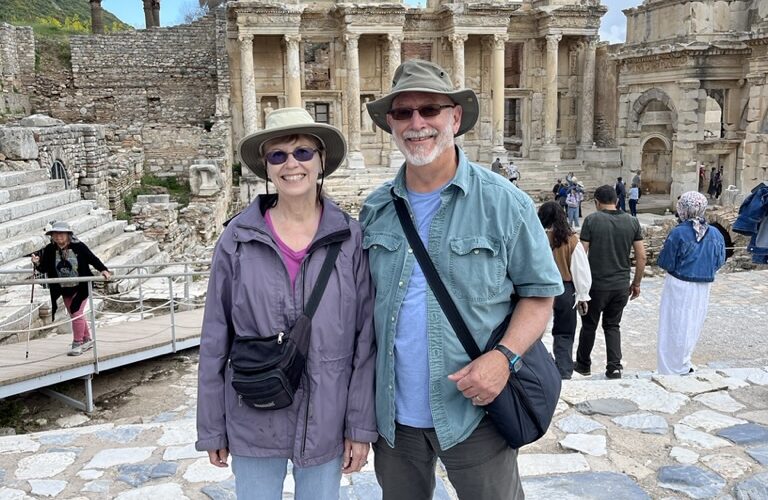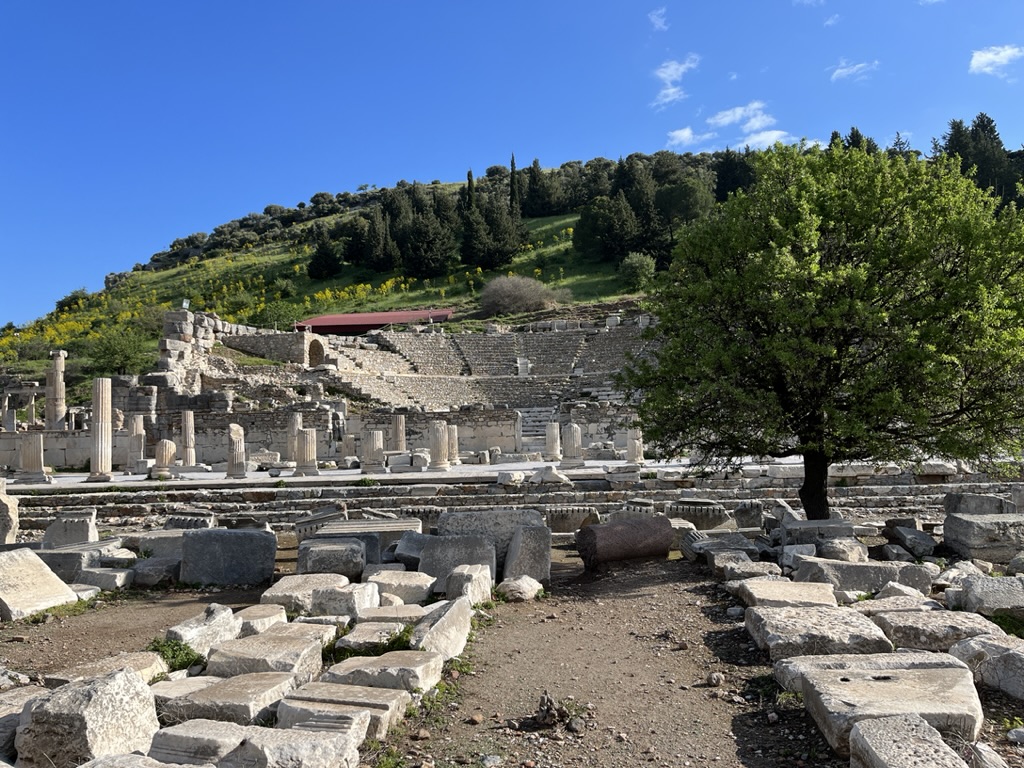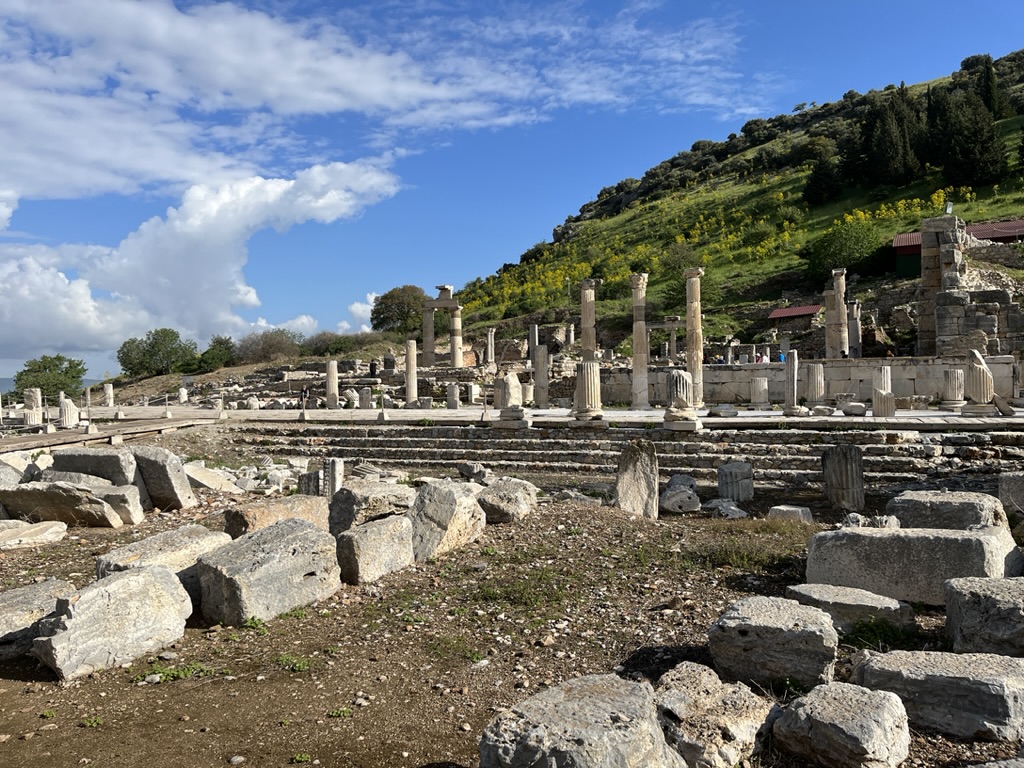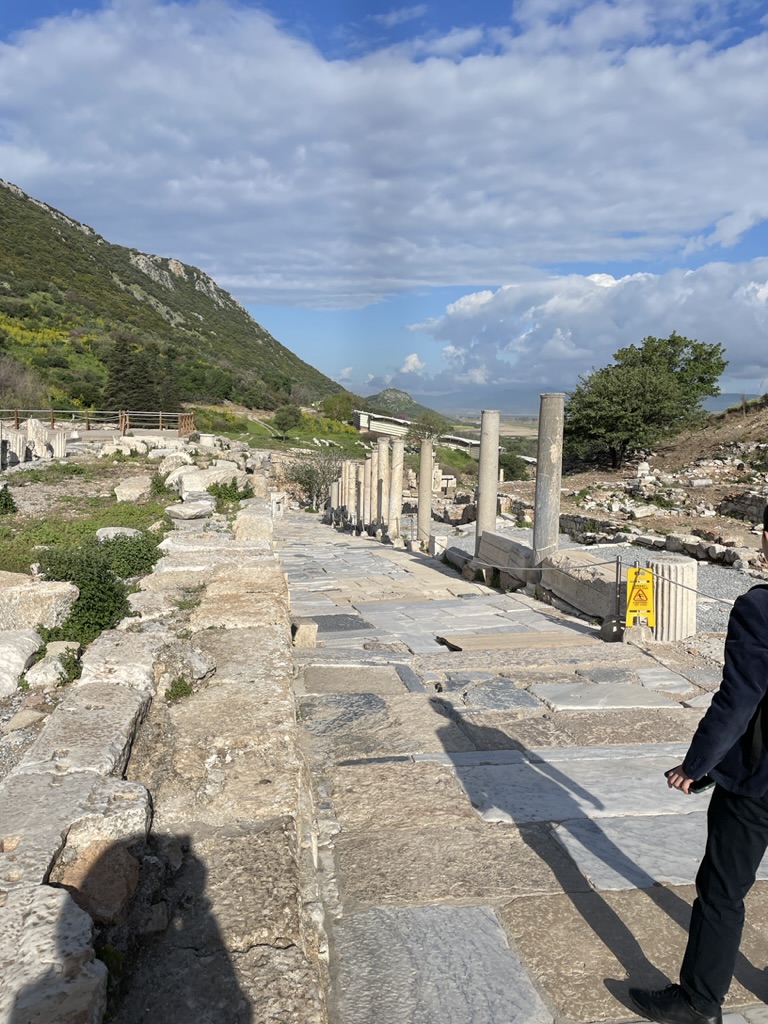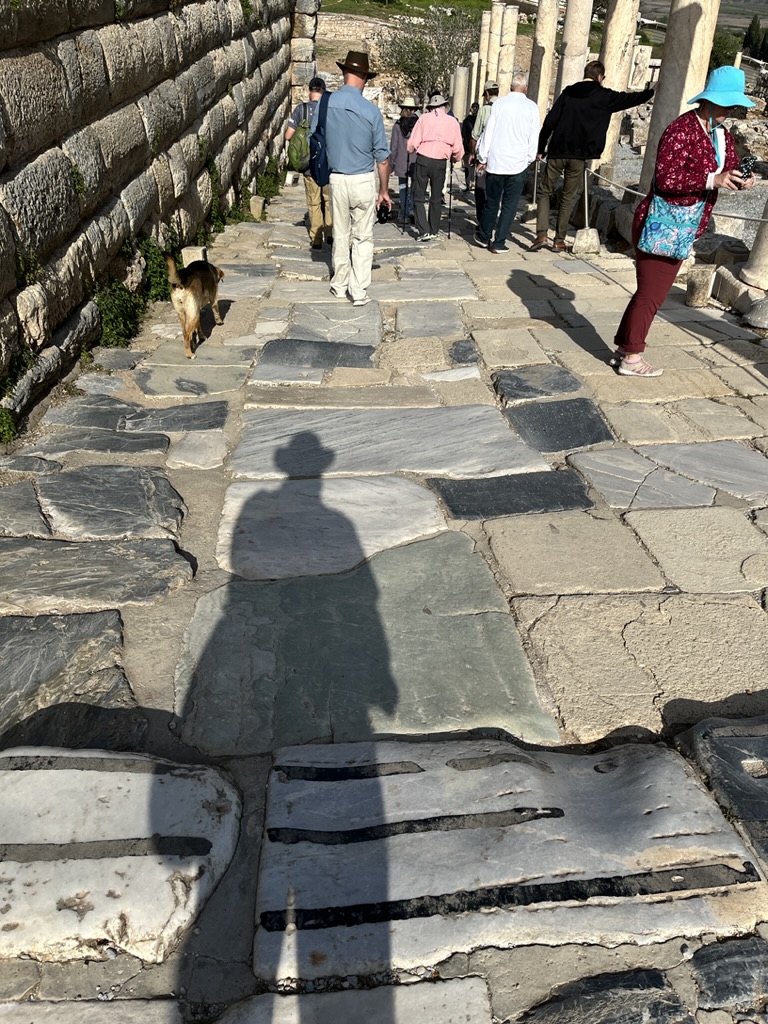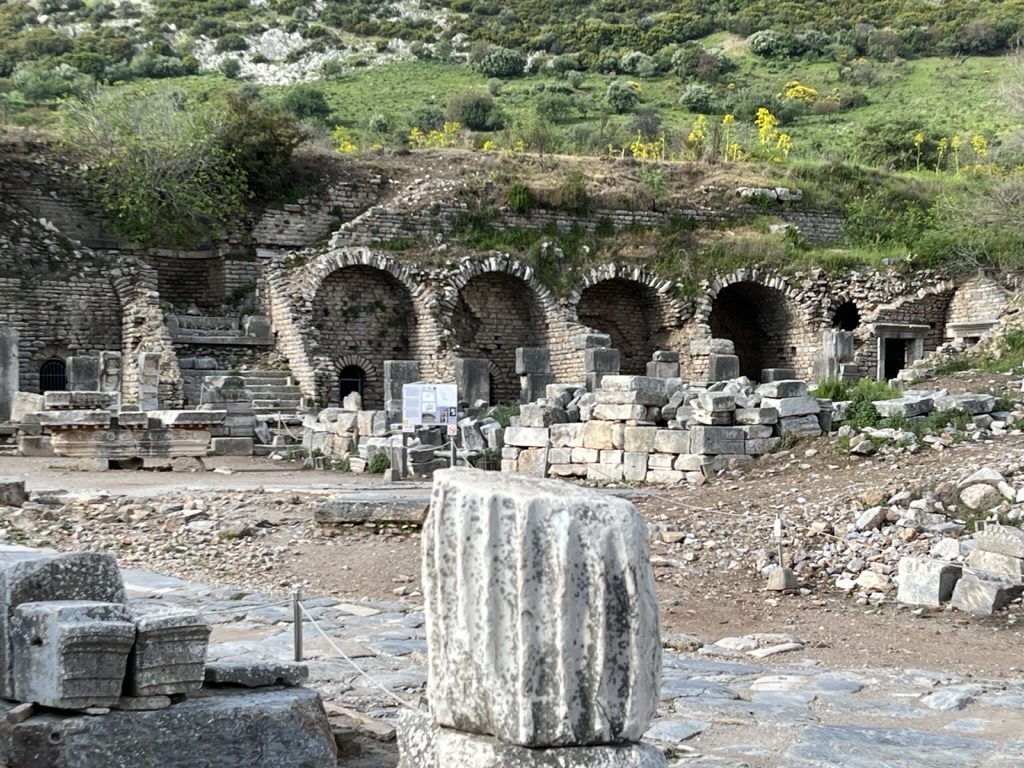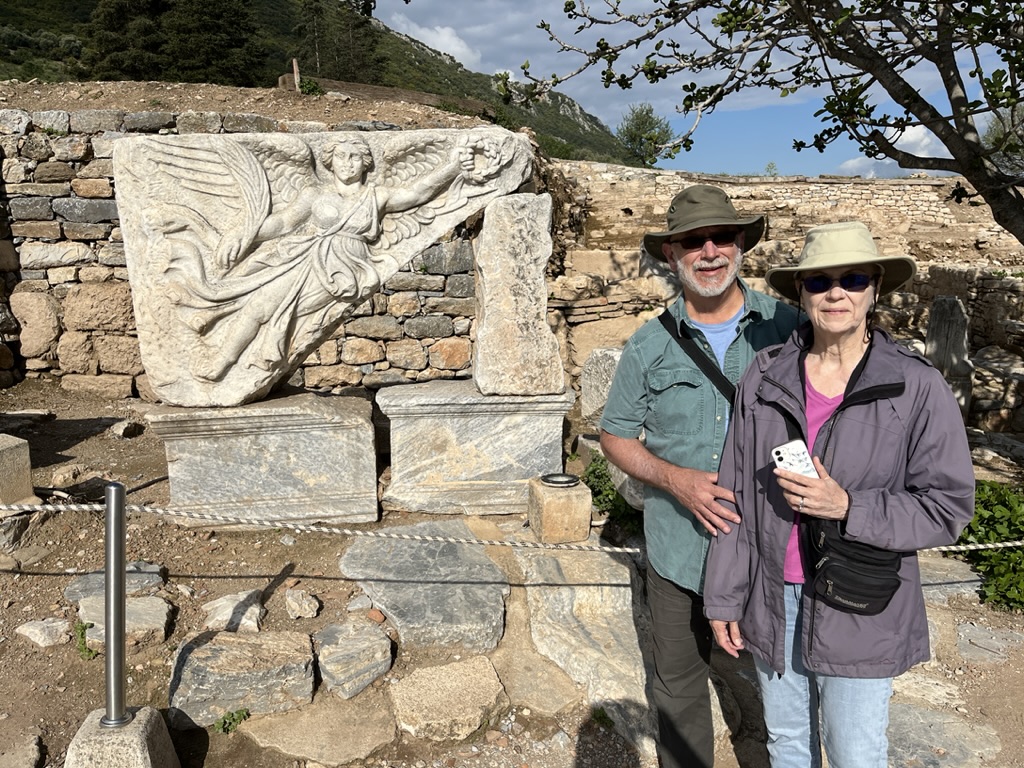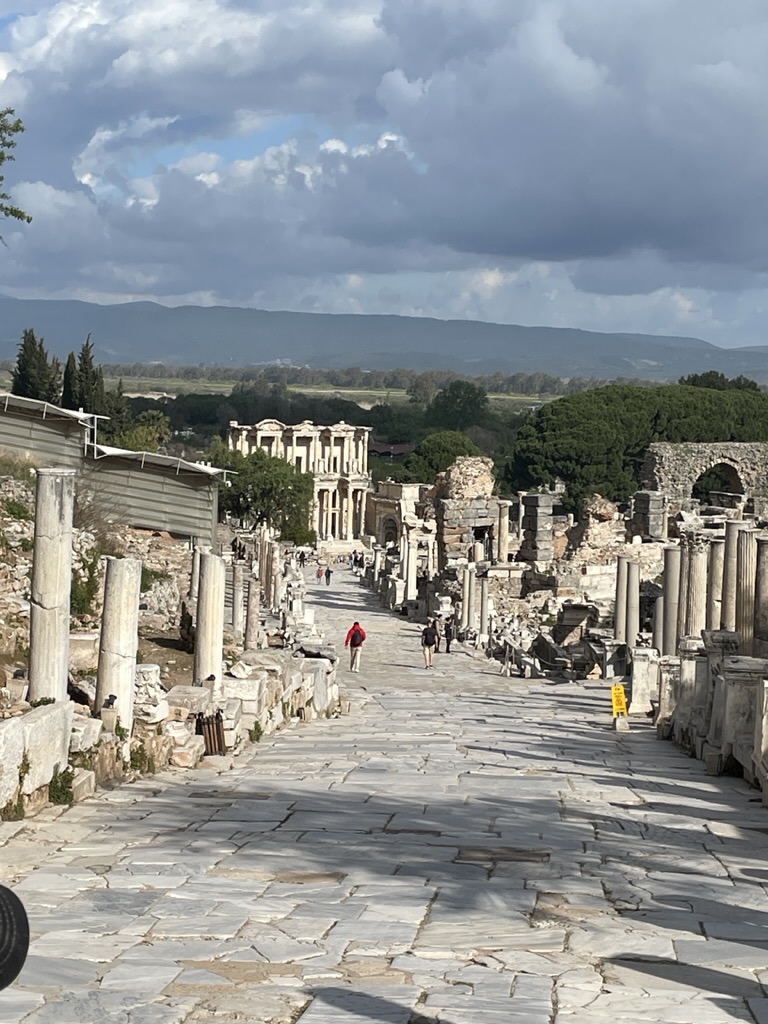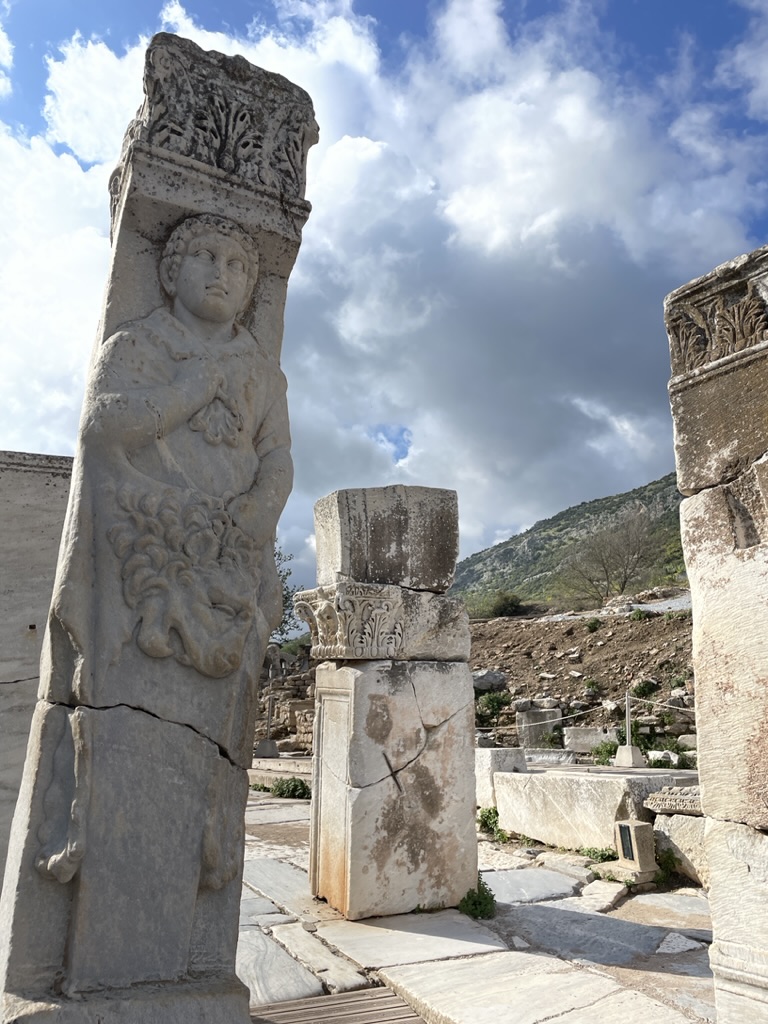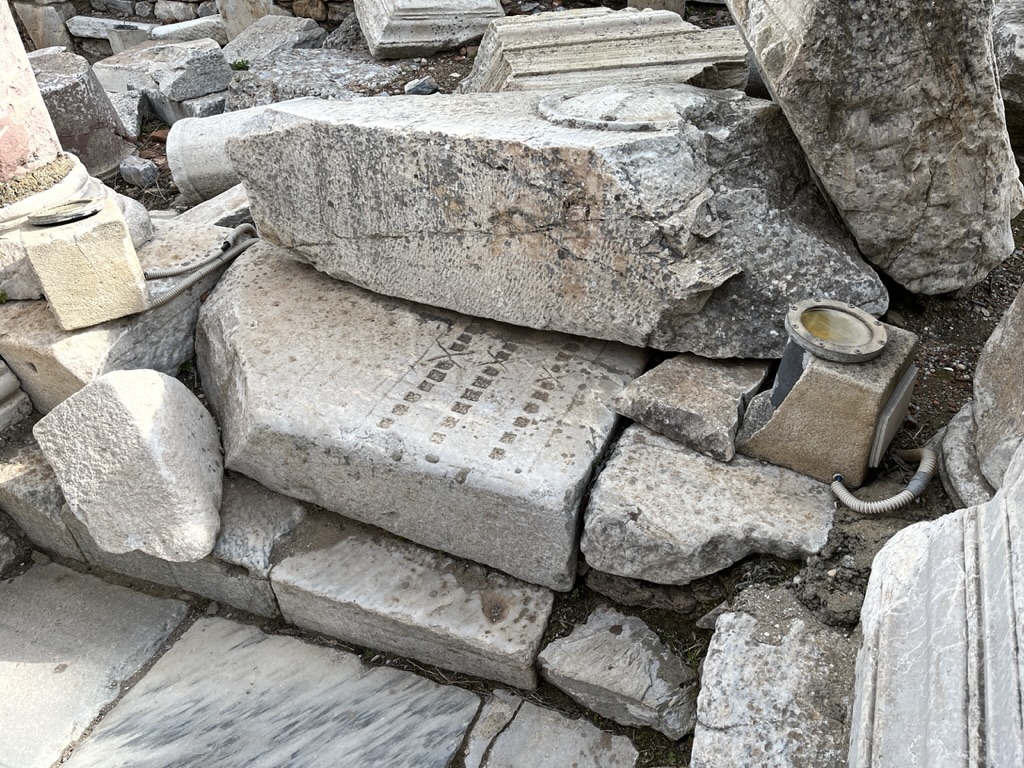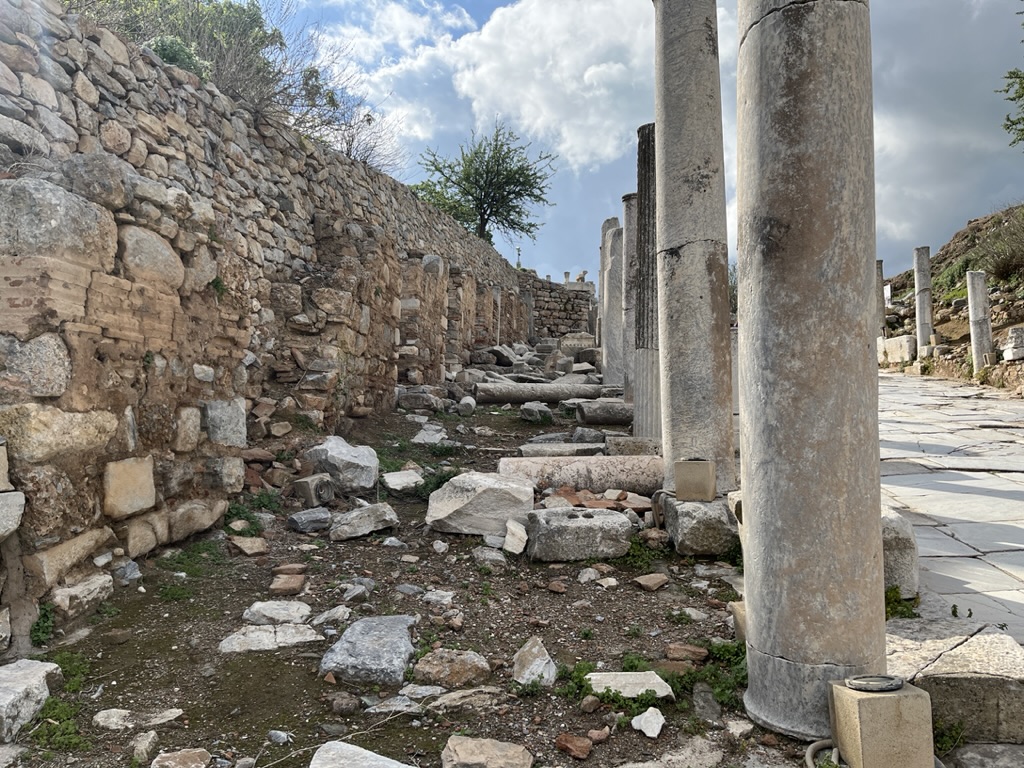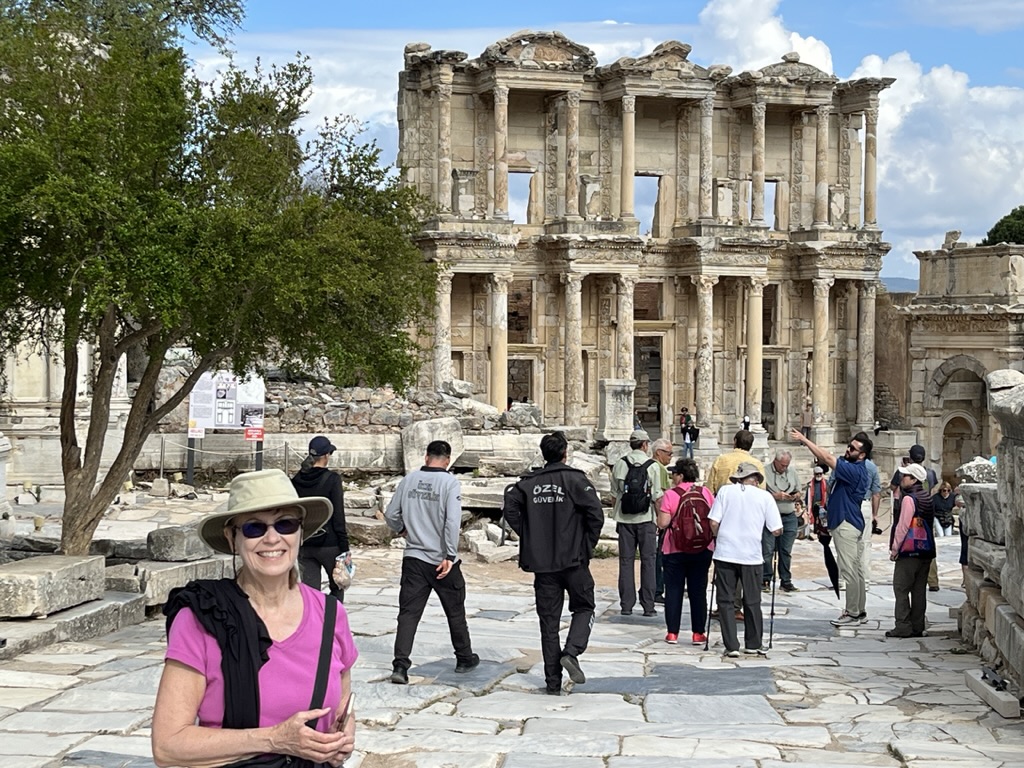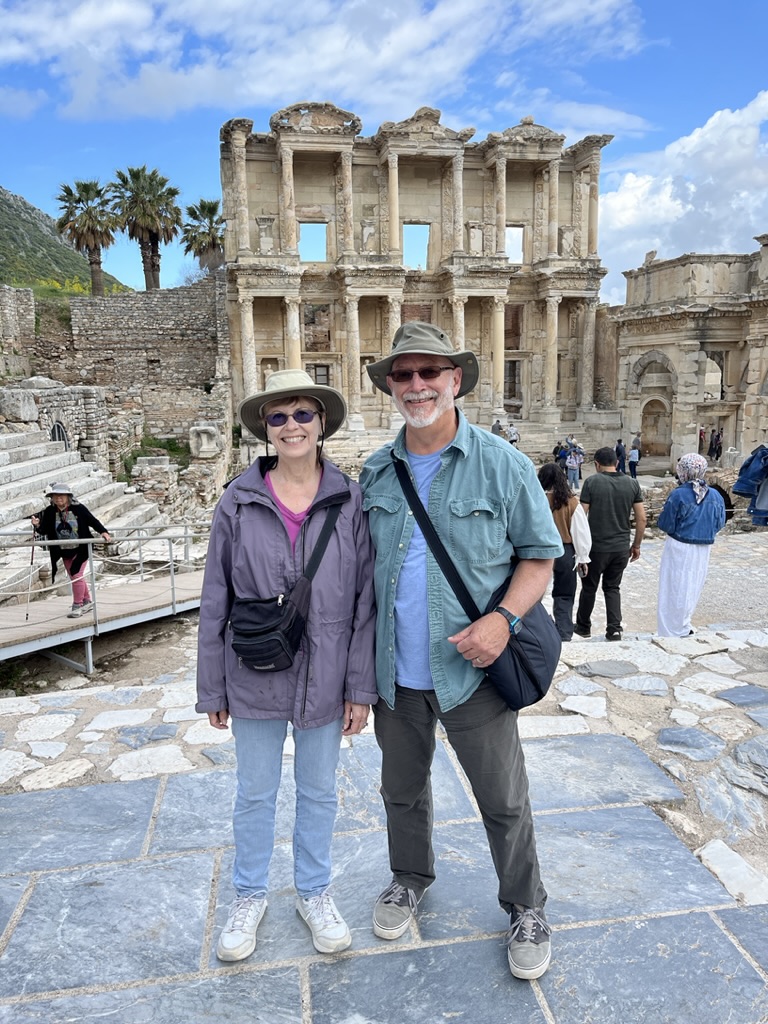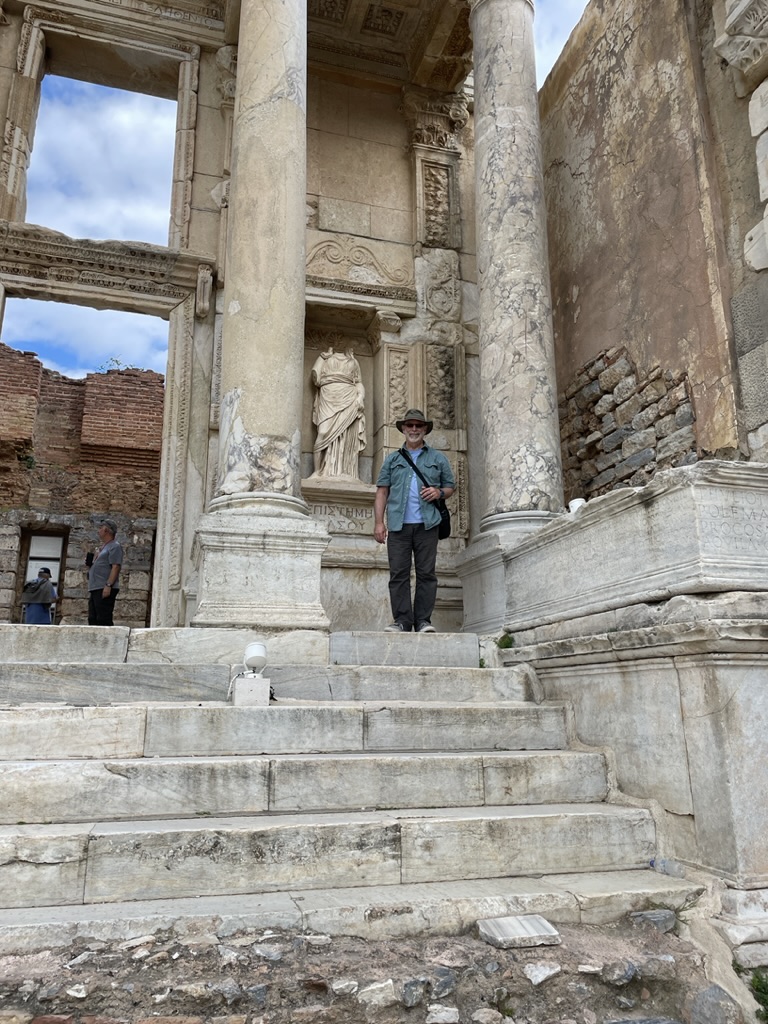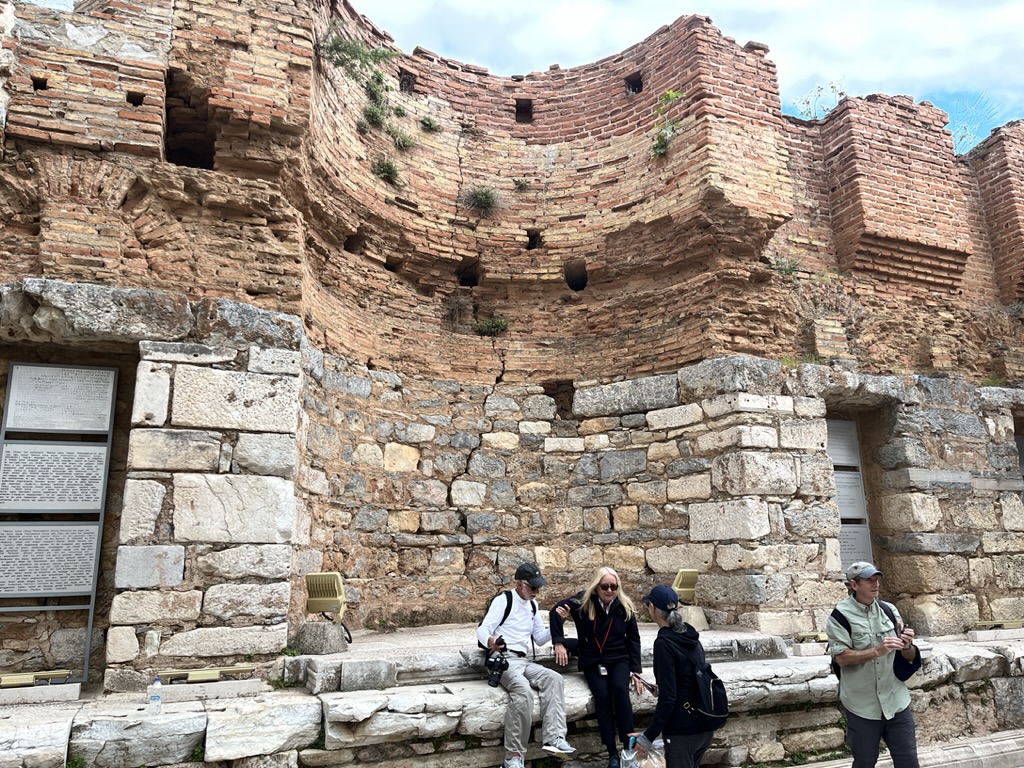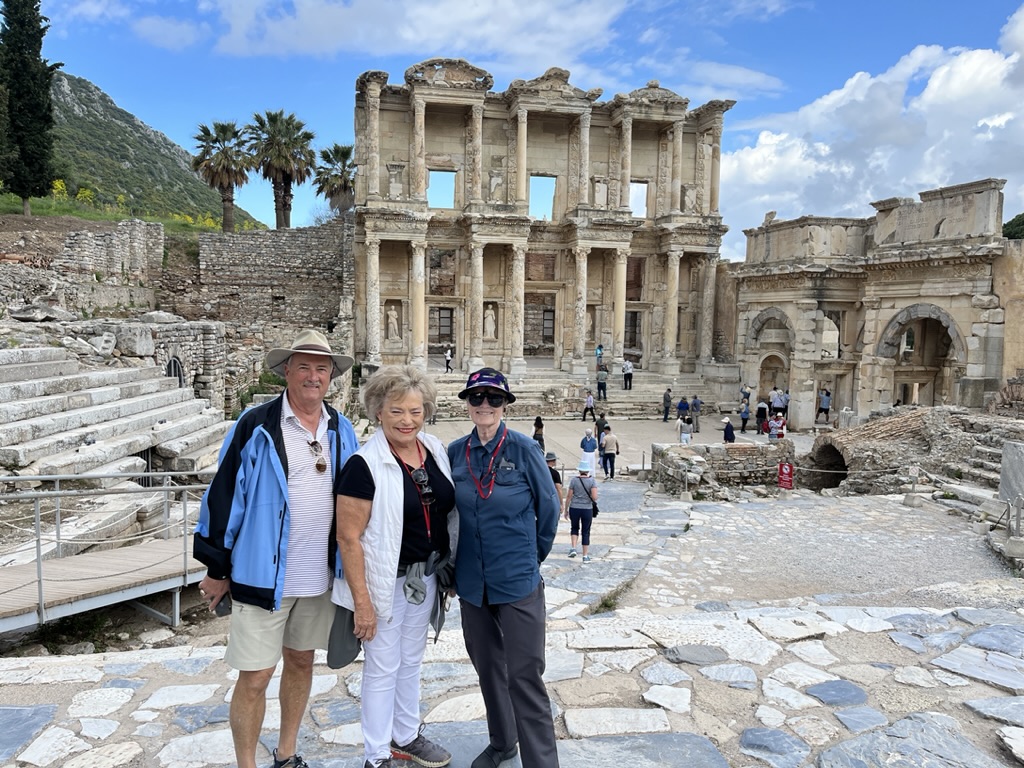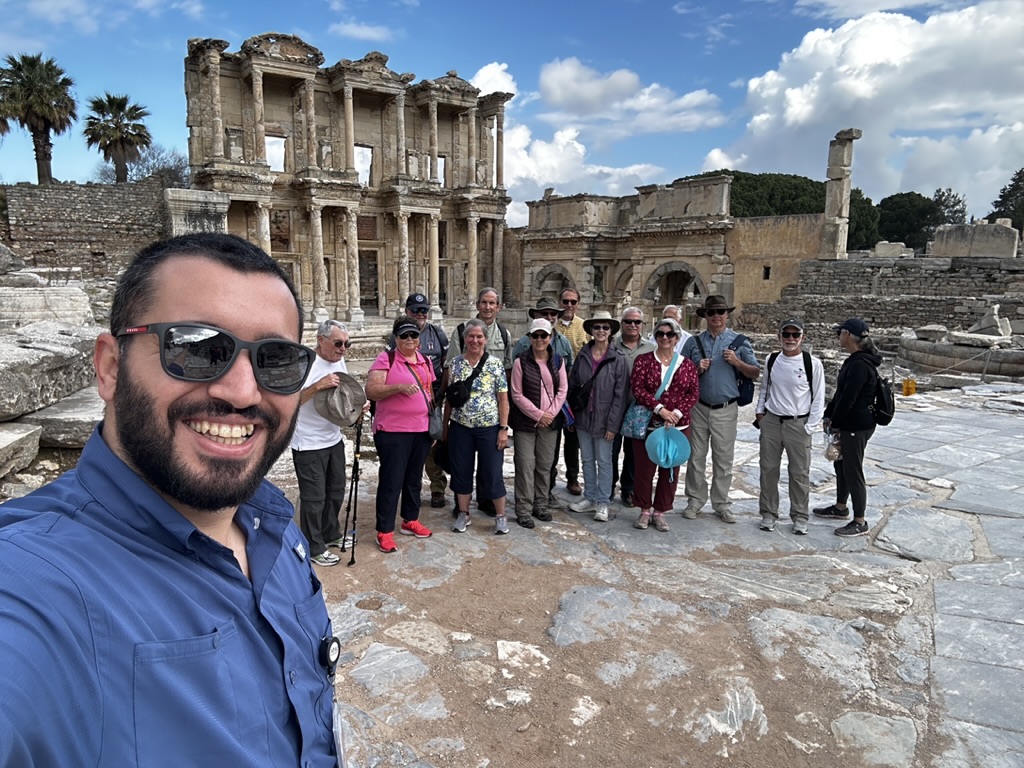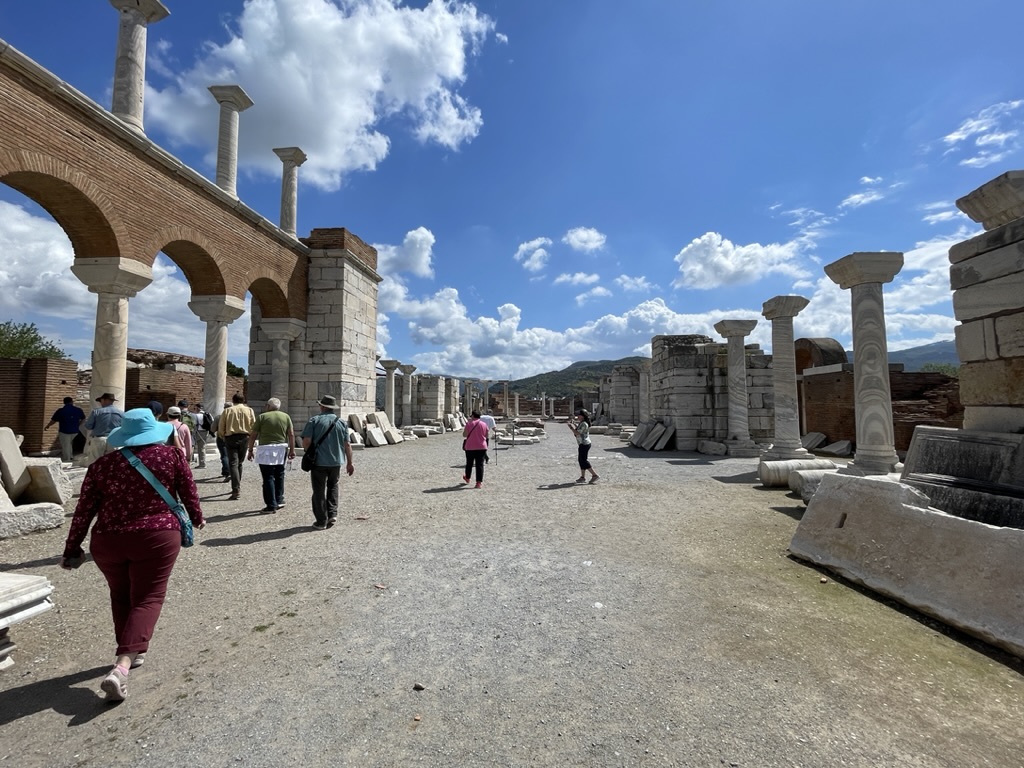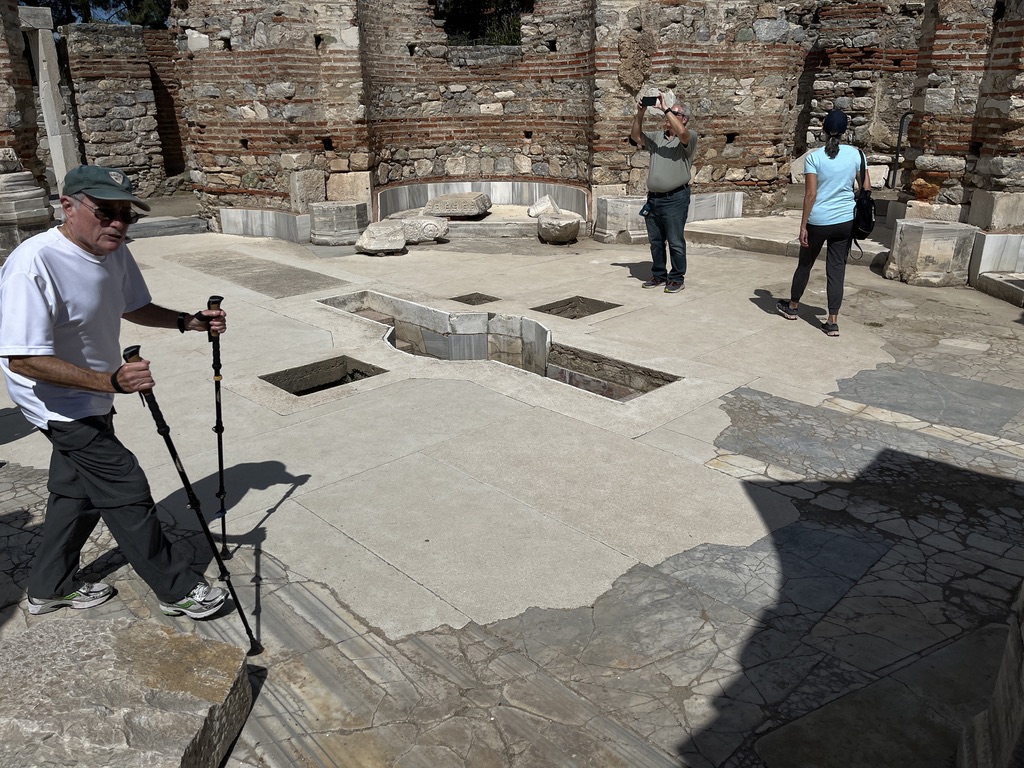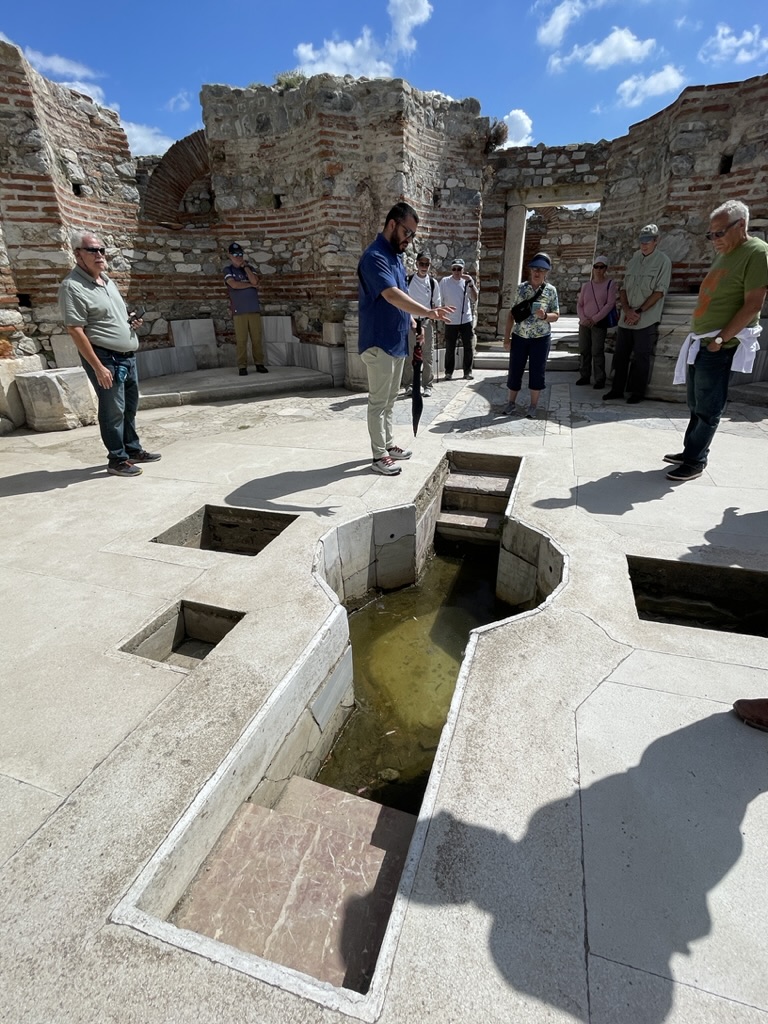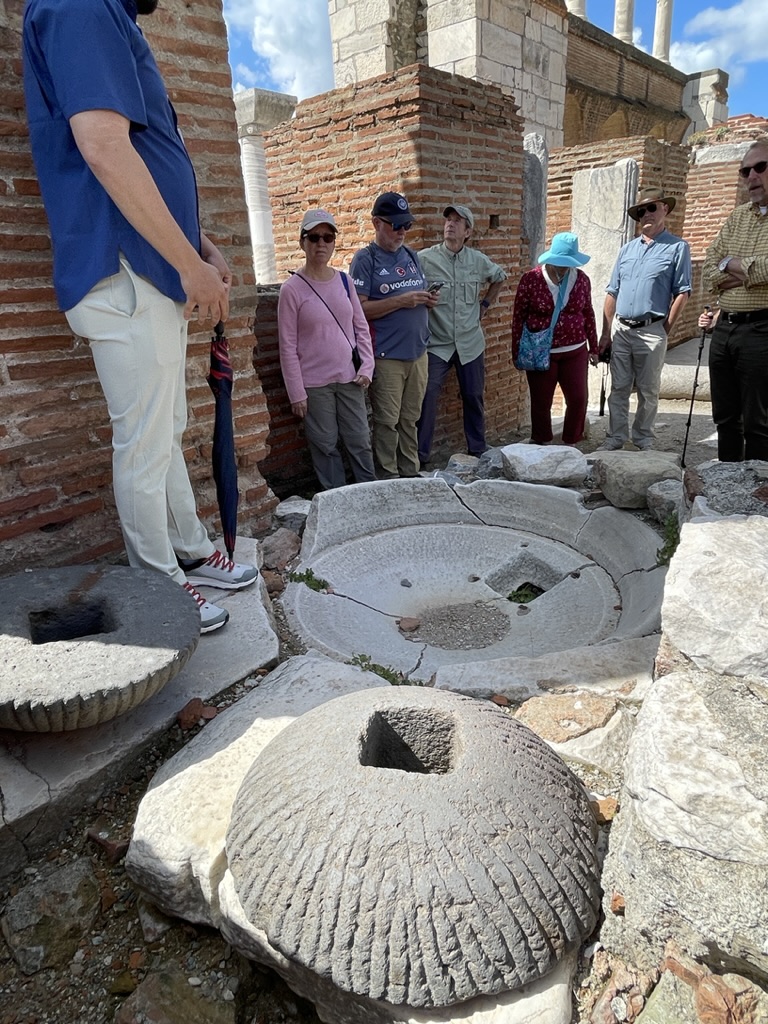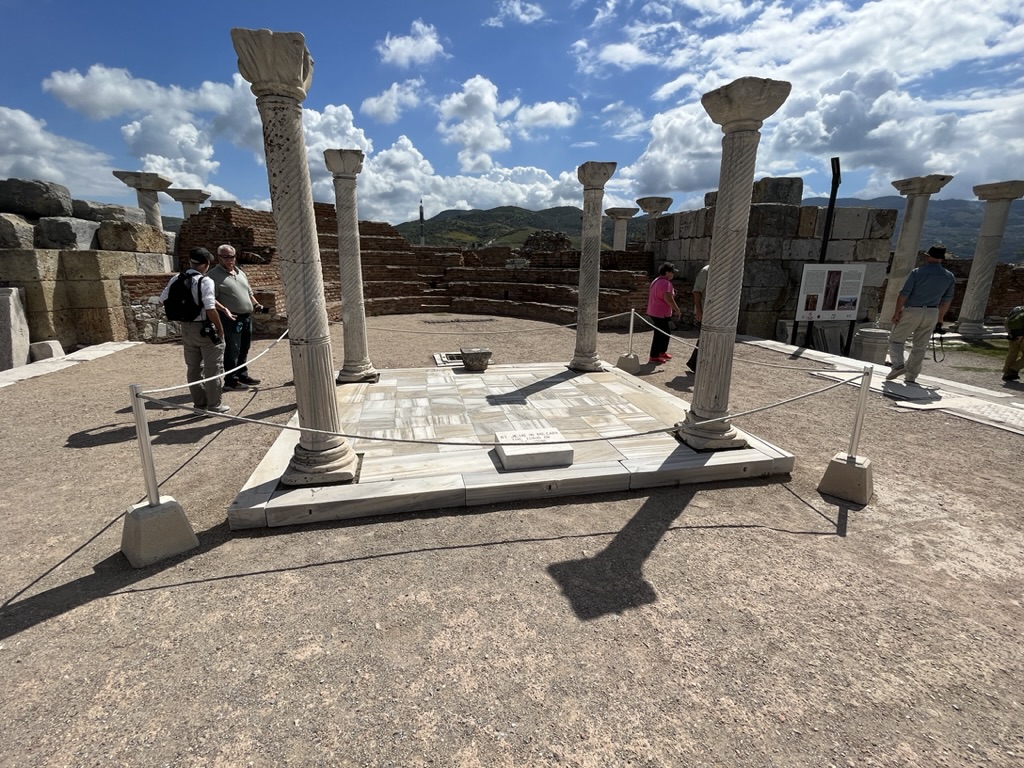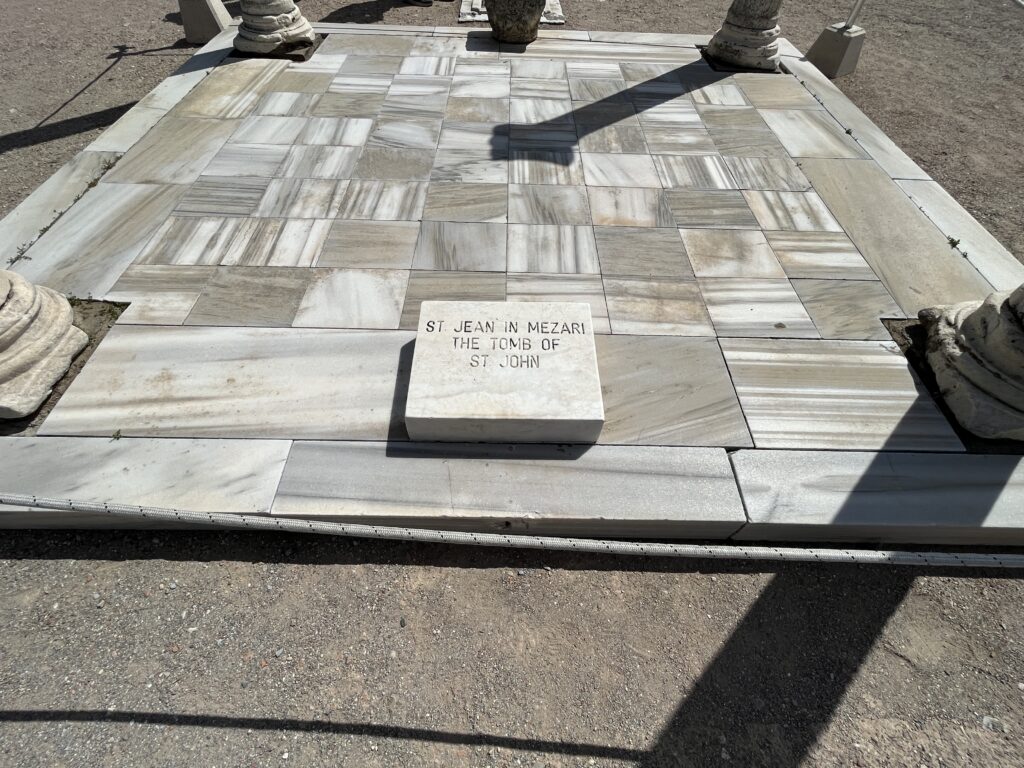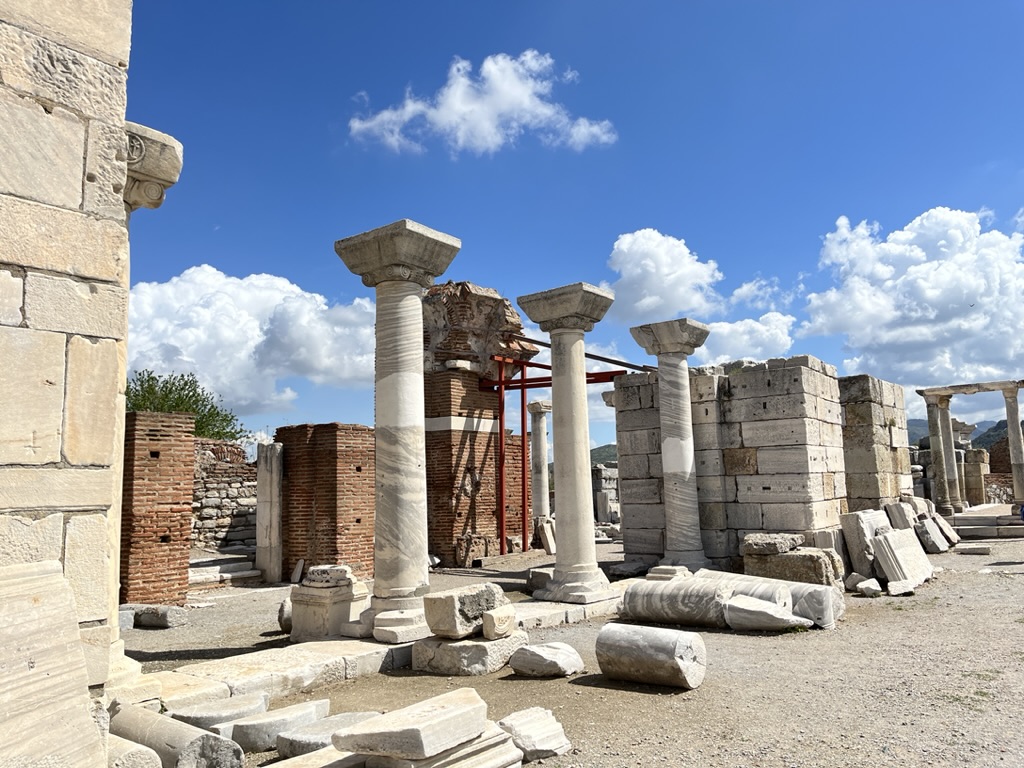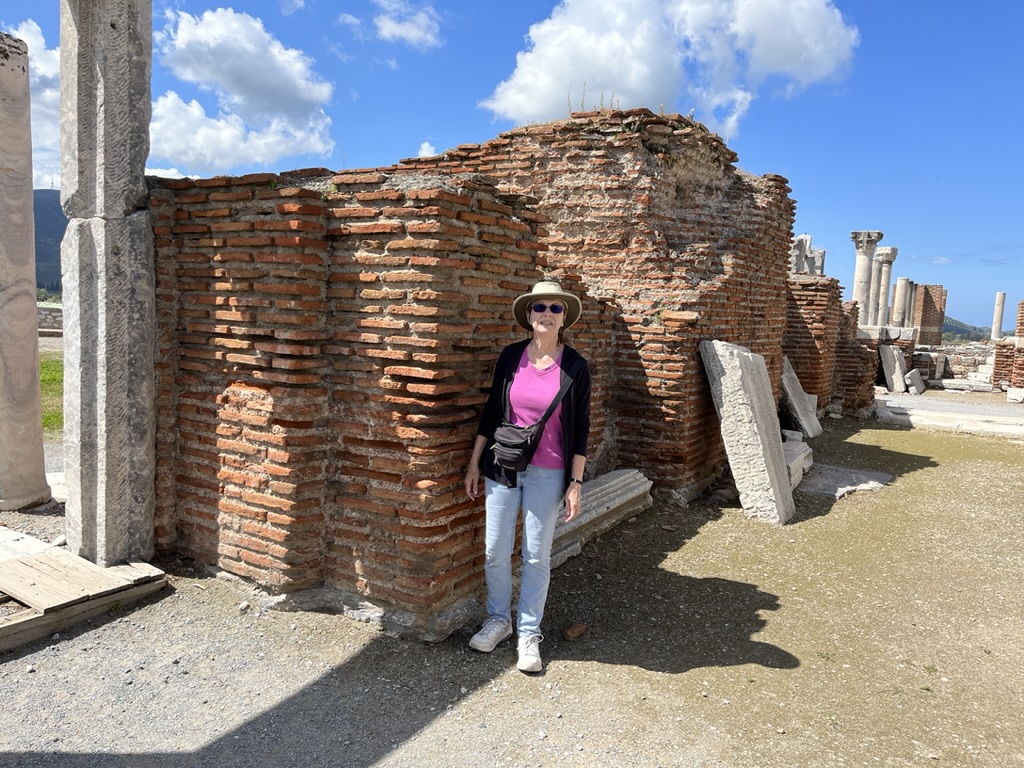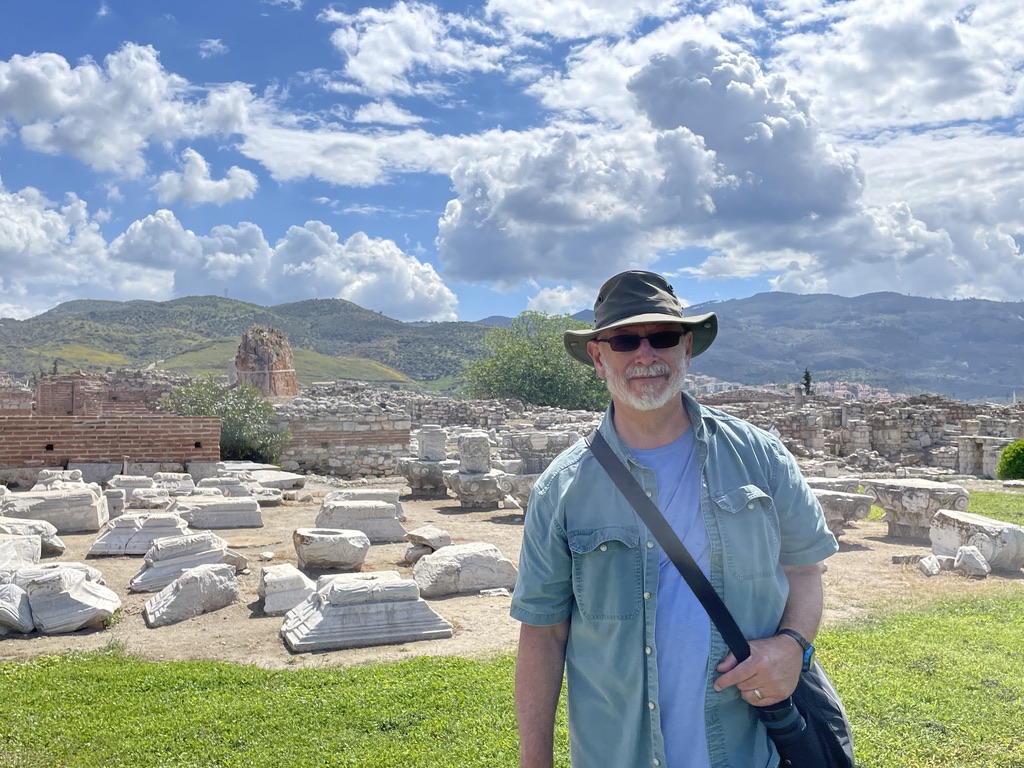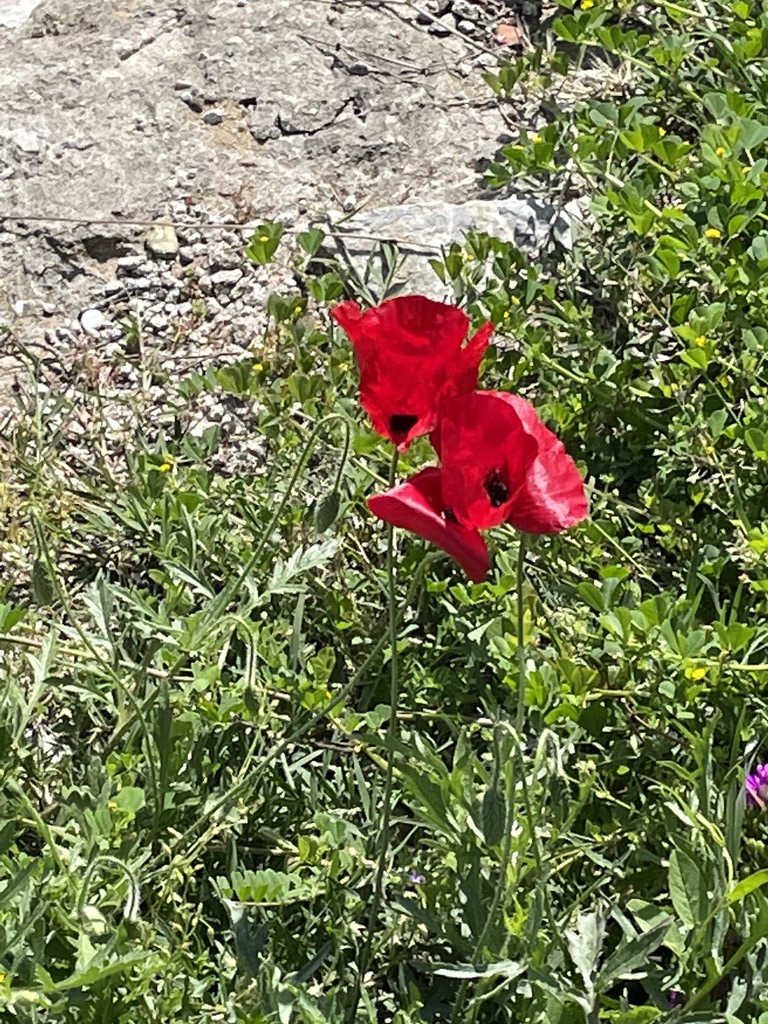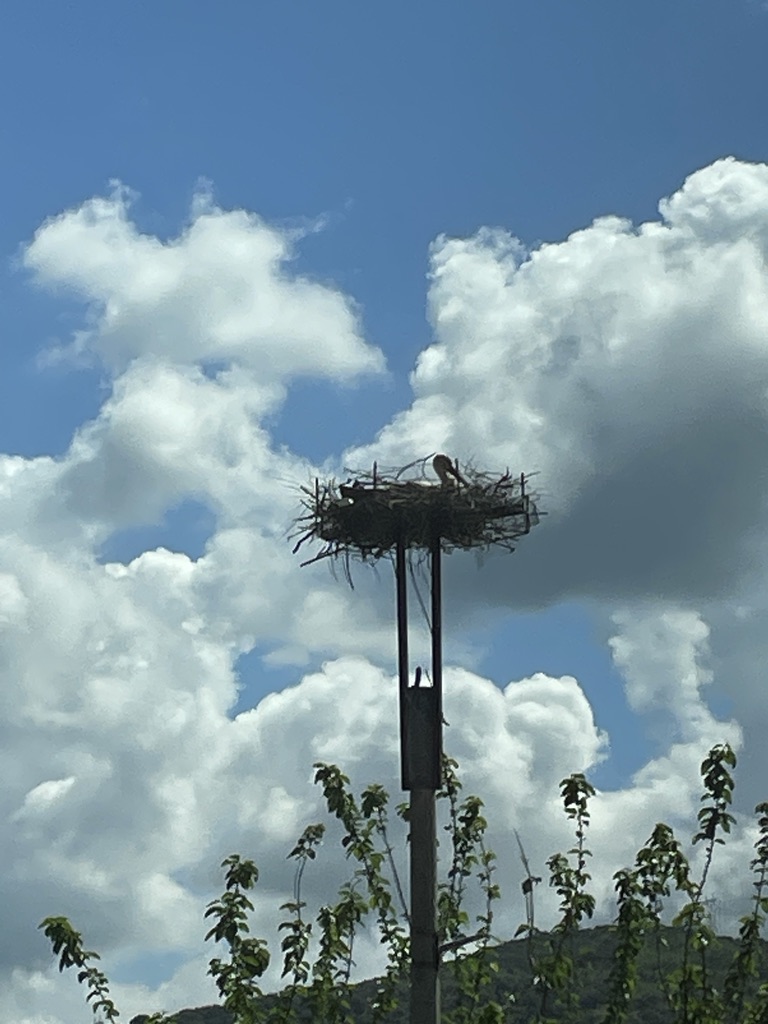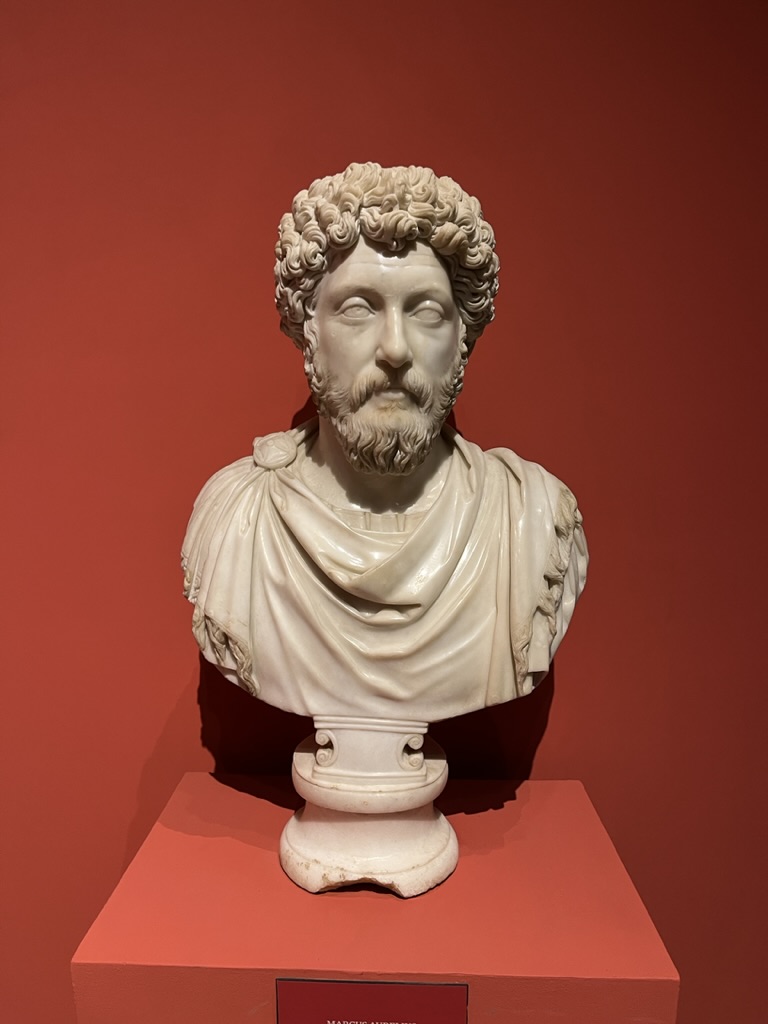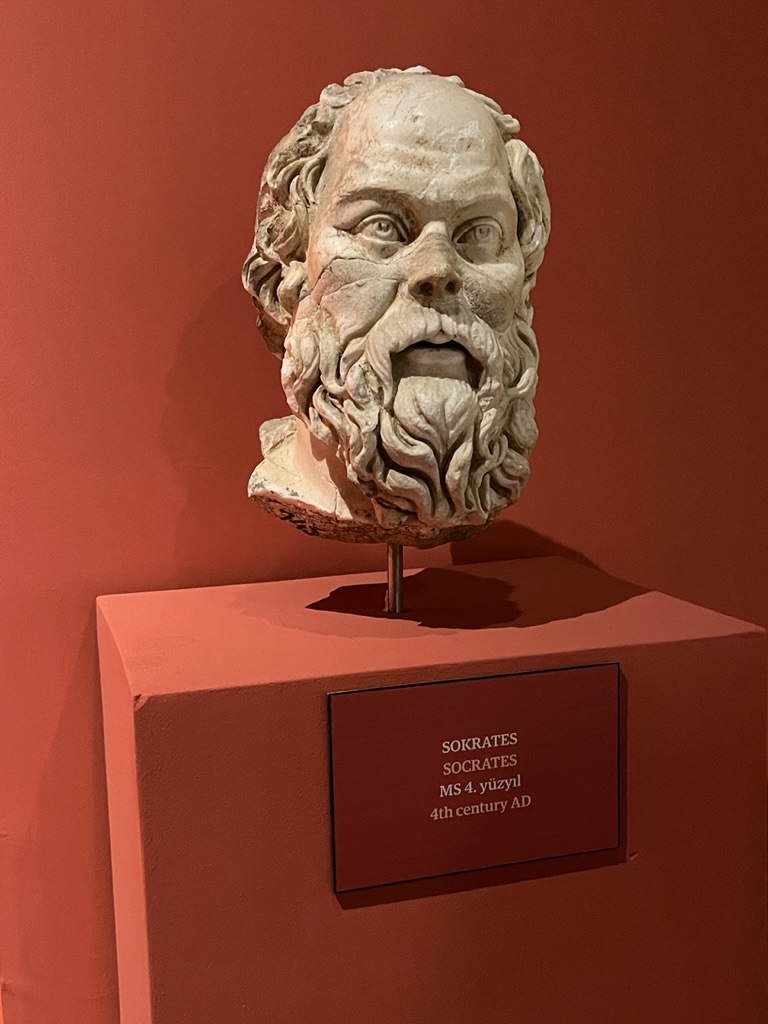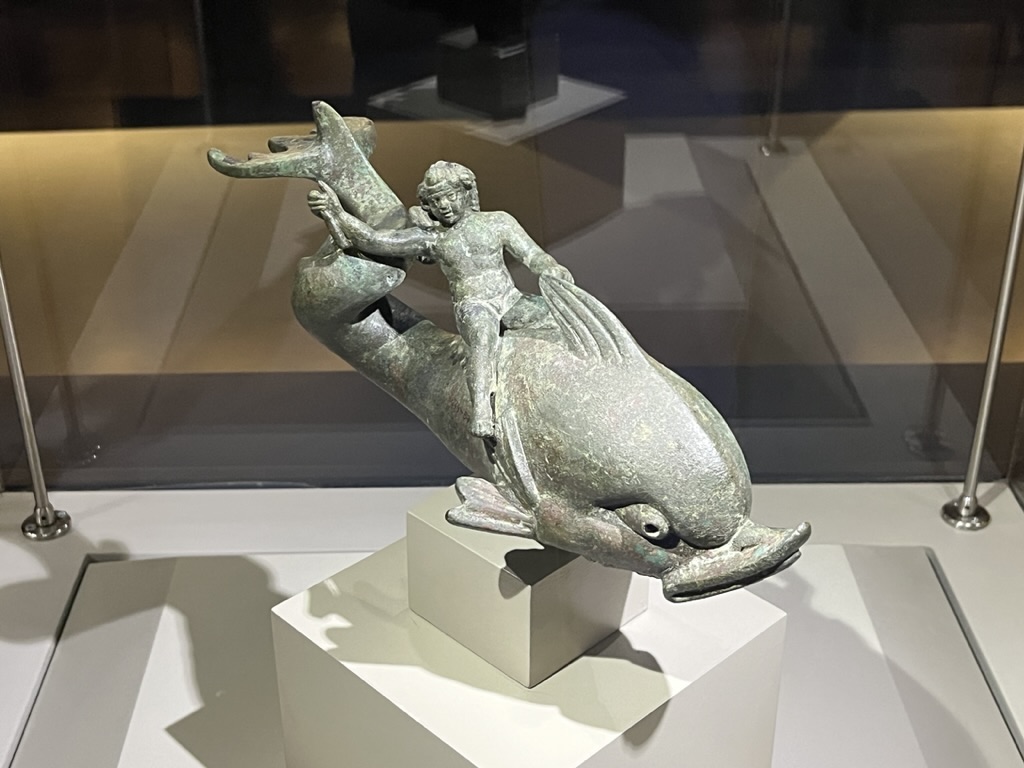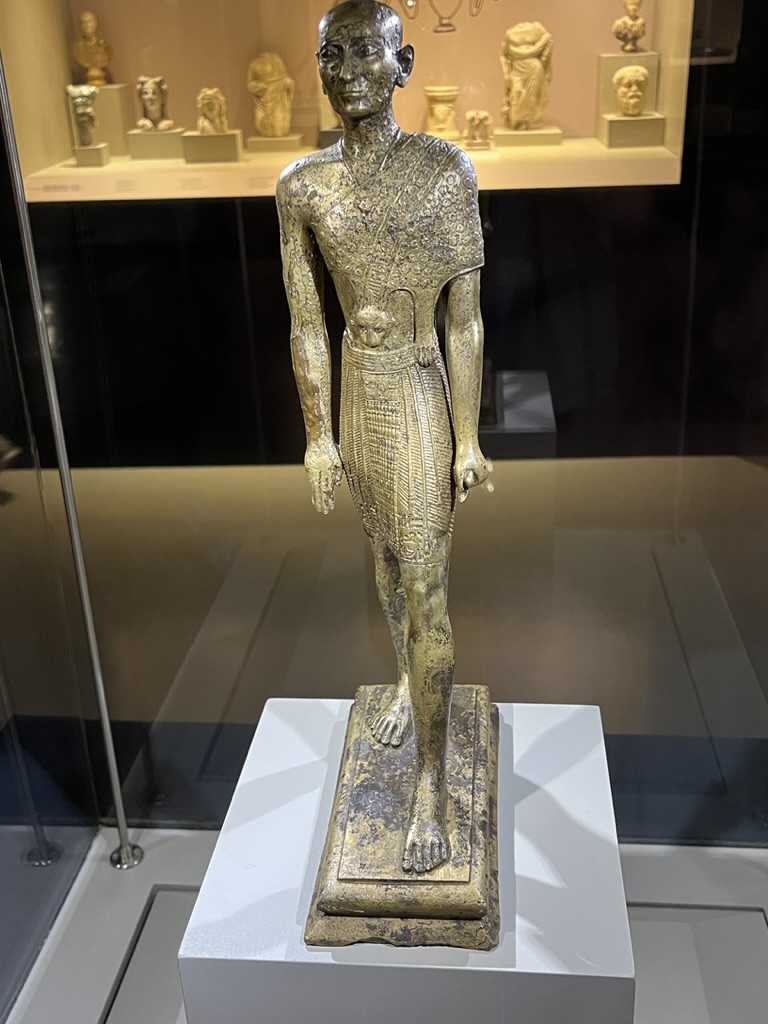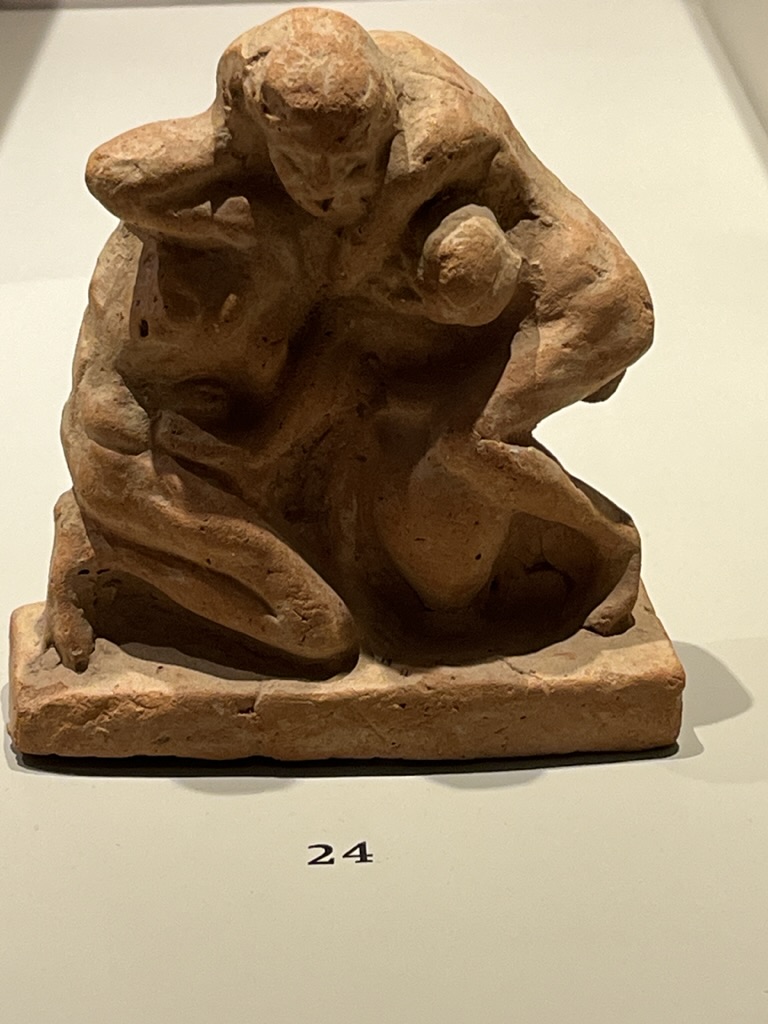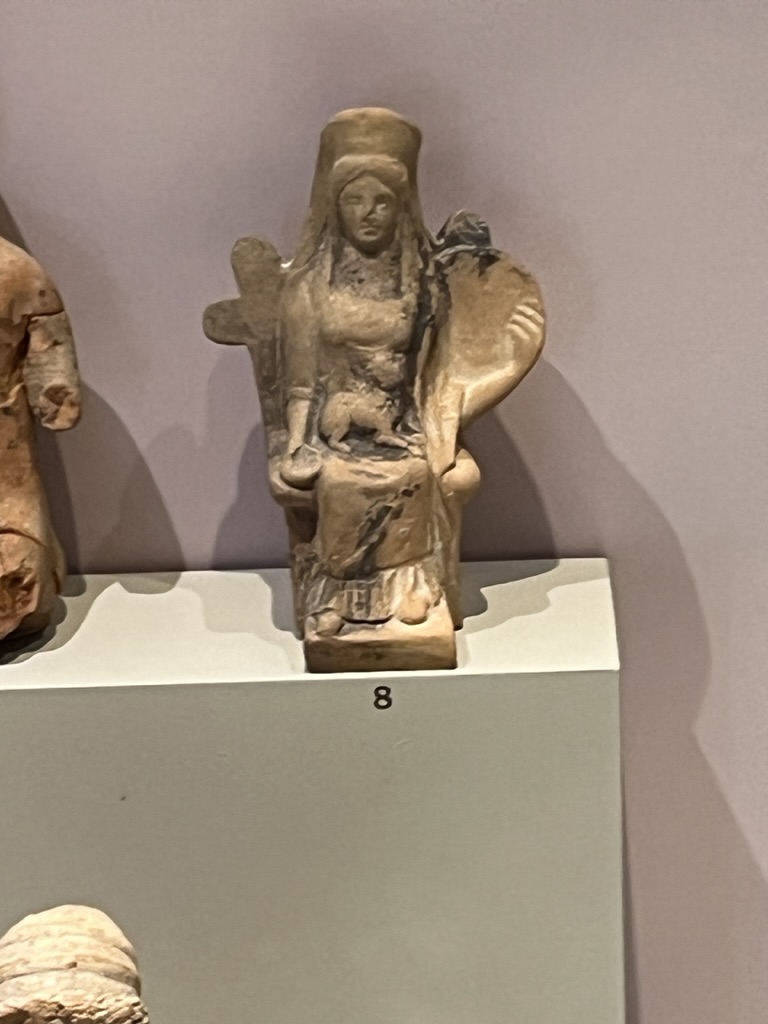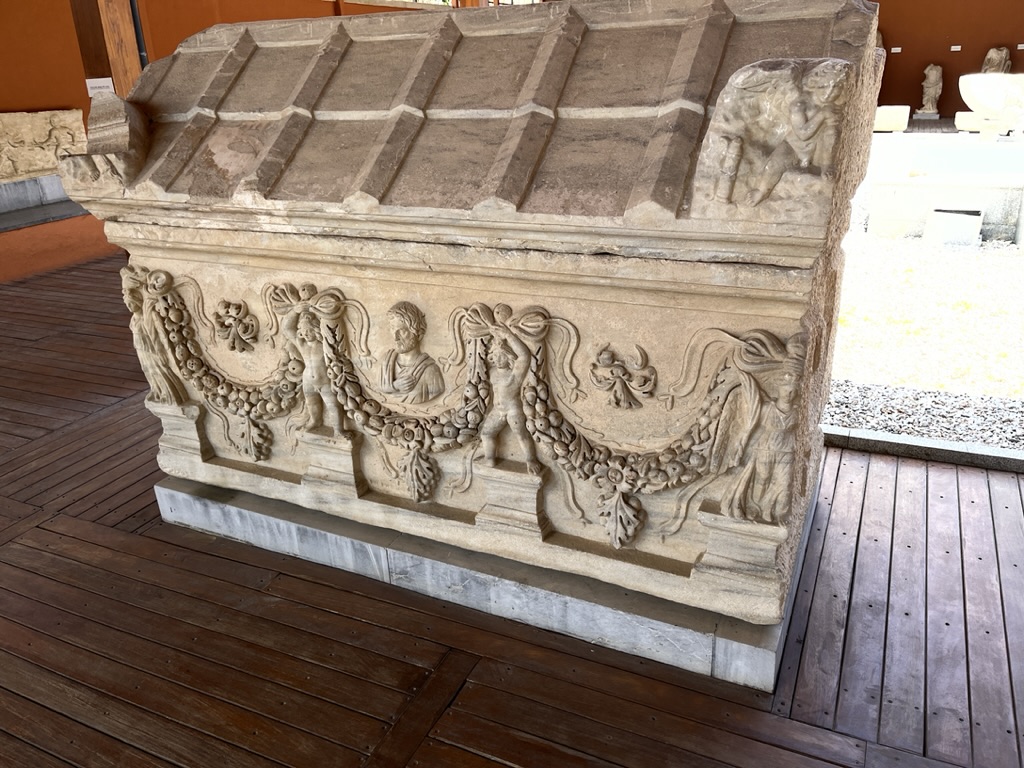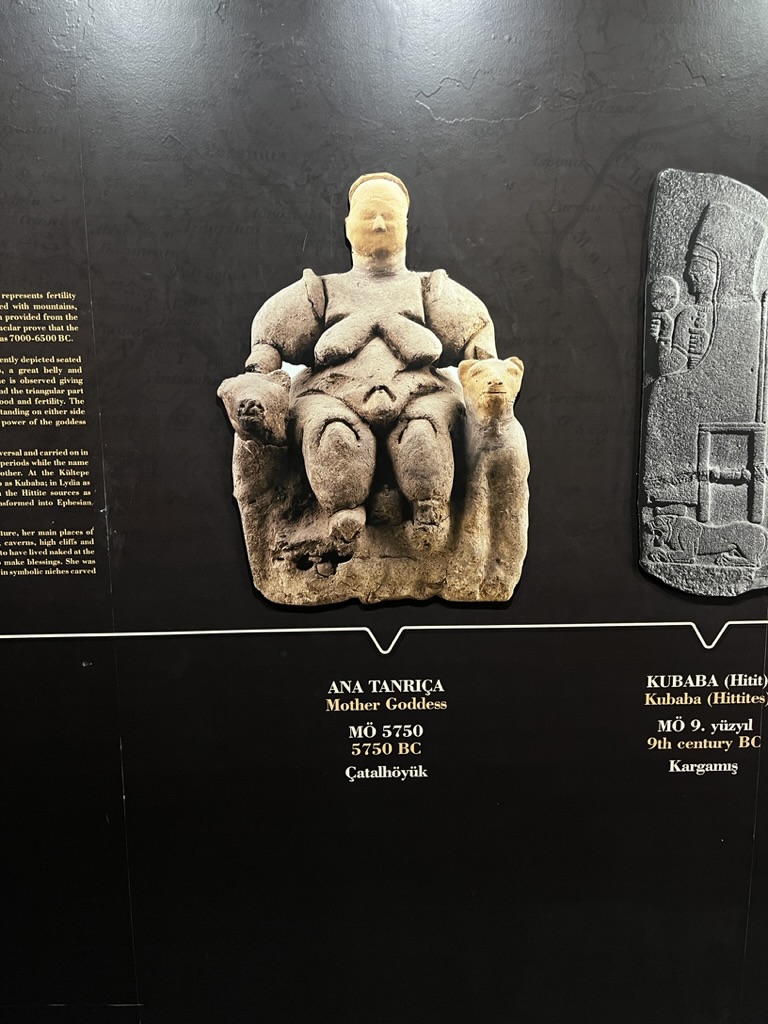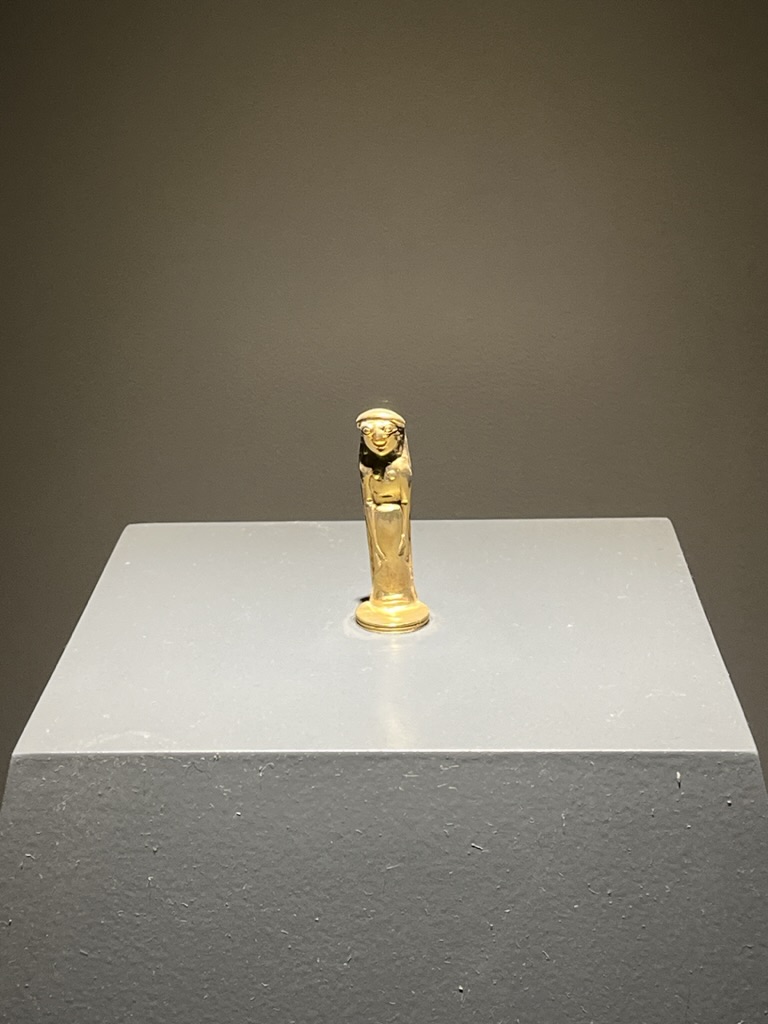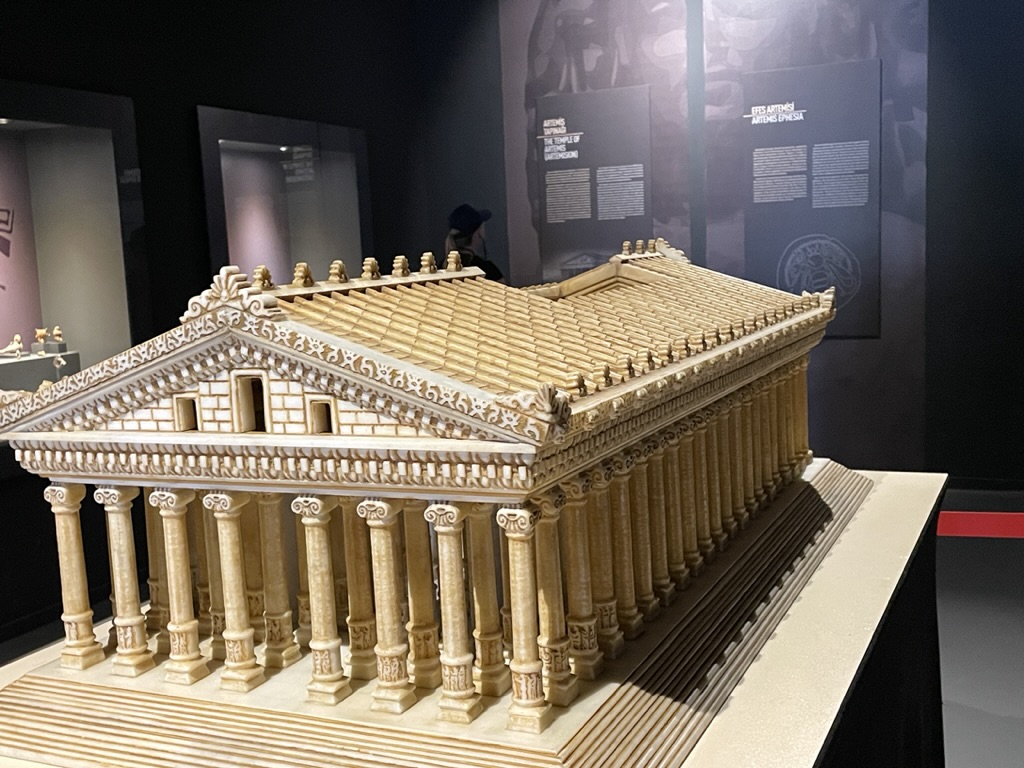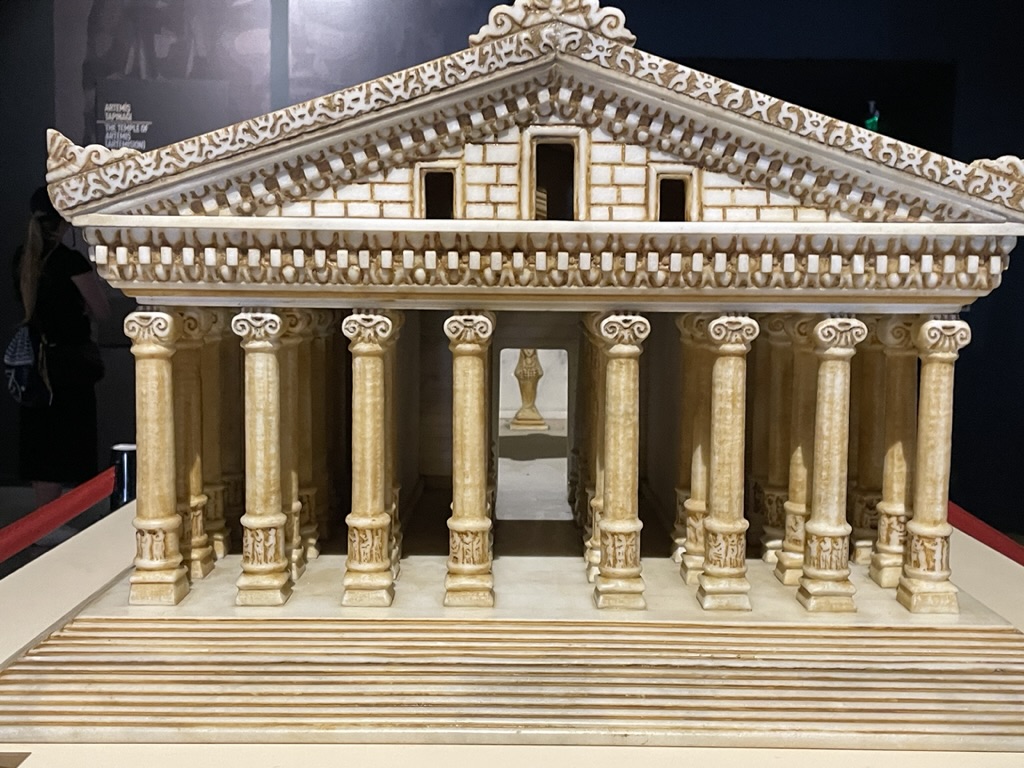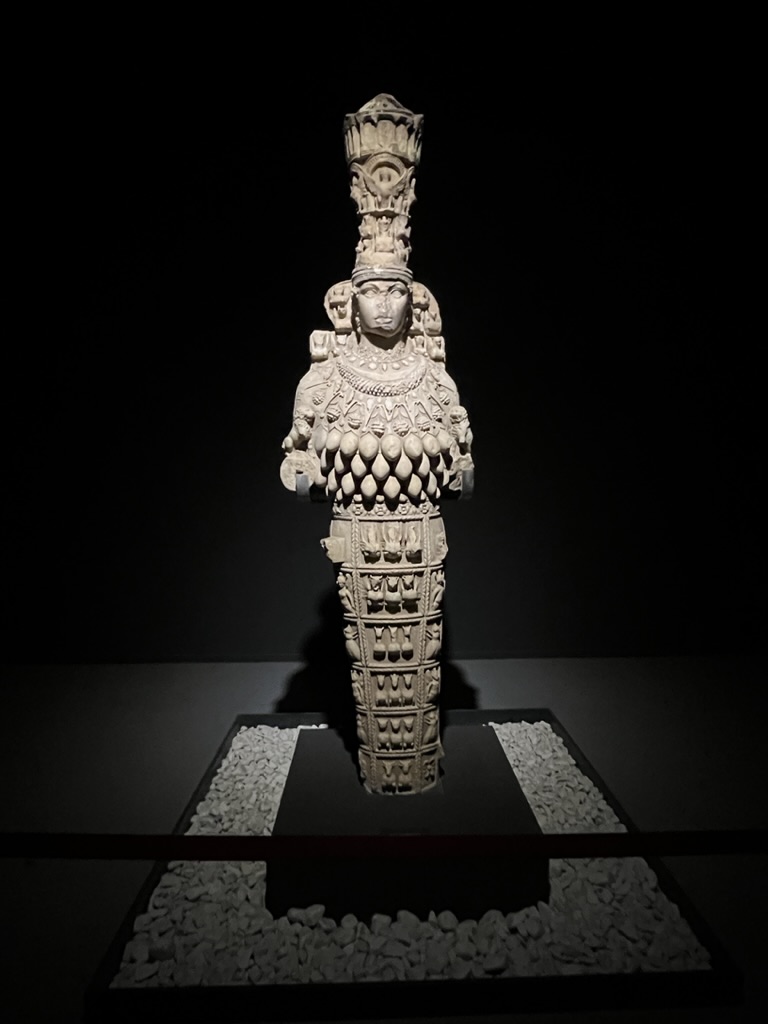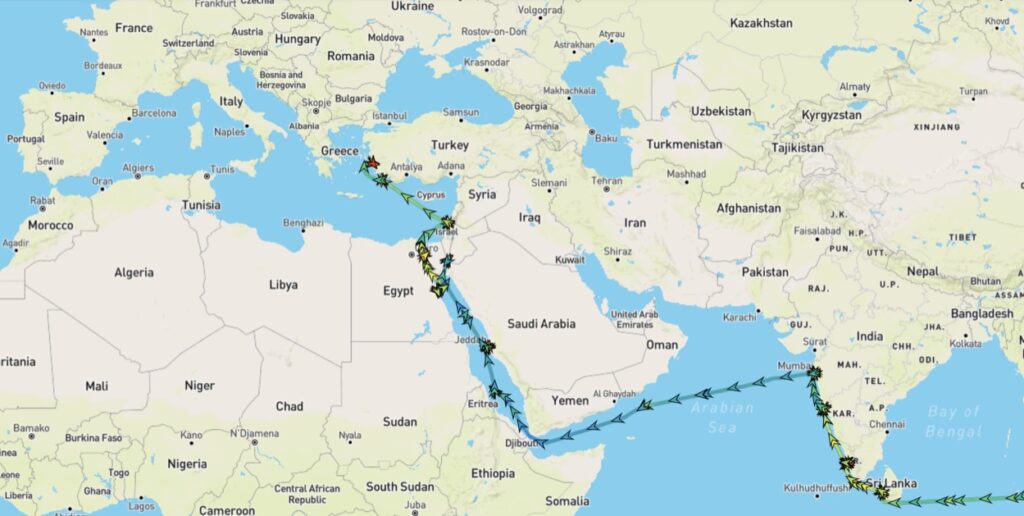
Noon Report:
- Location: N 37° 51.81′, E 027° 15.34′
- Speed: Docked
- Course: Docked
- Weather: Partly Cloudy
- Temperature: 12º C; 54º F
- Wind: SSW 7 knots; 9 mph
We docked this morning at the port of Kusadaski.
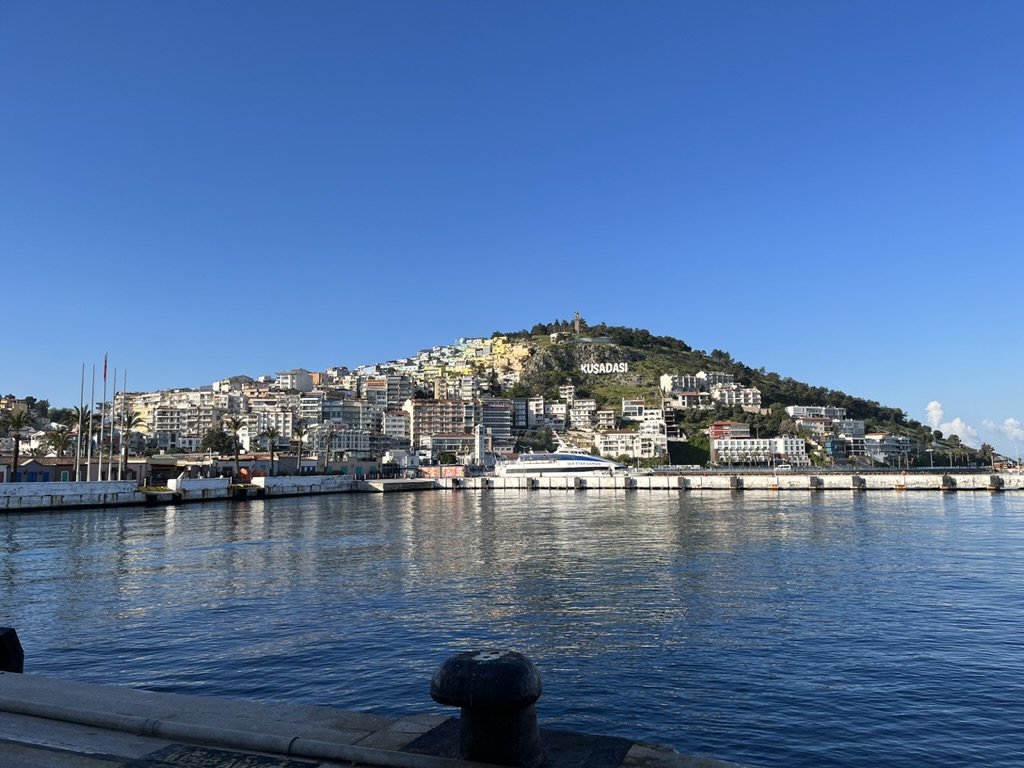
This is the port for Ephesus nowadays. Ephesus used to be the sea port, but during the first century BC the port started silting up to the point that the town had to be abandoned toward the end of the first century AD.
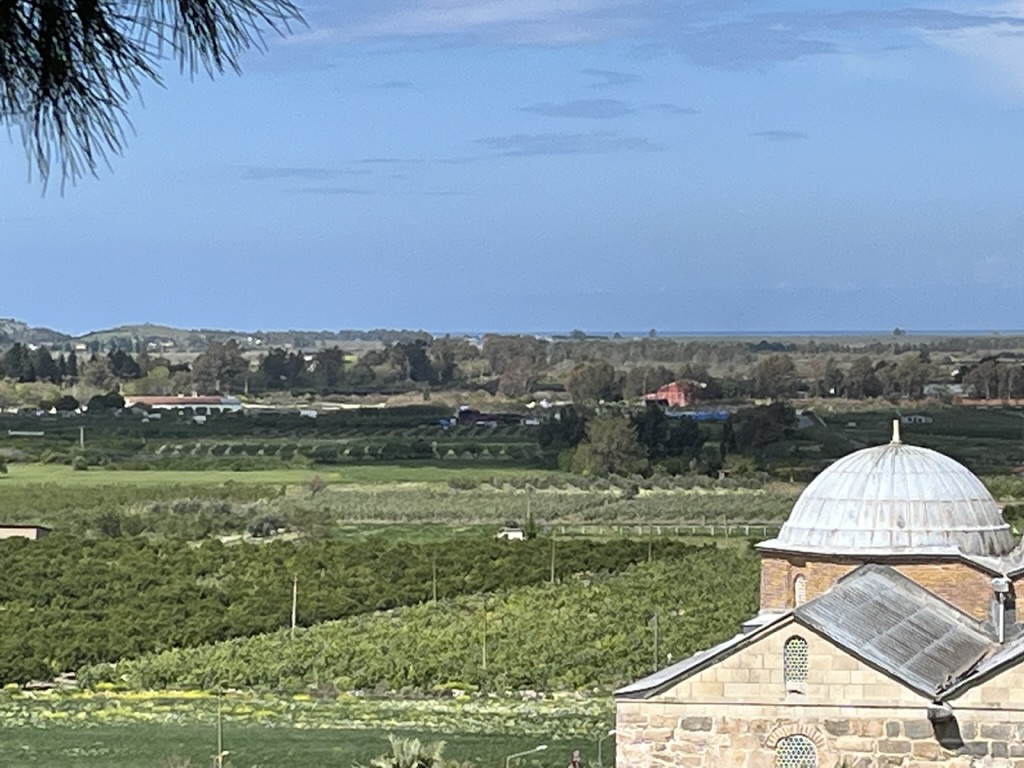
Our excursion today was a private tour arranged by friends on board. Fifteen of us in a small van, plus our guide Ismiel (“Call me Smiley”) and our driver, headed out from the port toward Ephesus. When Augustus became the Roman Emperor in 27 BC, he made Ephesus the capital of proconsular Asia (governing western Asia Minor) – which made it a prosperous center of commerce. It was the second largest city in the Roman Empire and at its peak the city had over 250,000 residents.
Currently about 15% of the town has been excavated. The excavated part is along a major street leading down the hill from the government section to the commercial part of town. We started at the top.
Farther down the street we passed a large building that was probably the health care center or hospital. In front of this building was a large stone carved with a snake that winding around some kind of stick (the “Rod of Asclepius” is the traditional symbol of medicine from Grecian times – it only has one snake and is never depicted with wings). (OK, I’m not buying the ‘from Gecian times’ bit. That’s what Ismael said but I contend that the symbol dates back to the Exodus of the Hebrews from Egypt. But that’s just my opinion. I’ll sit down now. R) Directly across the street is another large stone with a mortar and pestle carved into it – possibly the pharmacy.
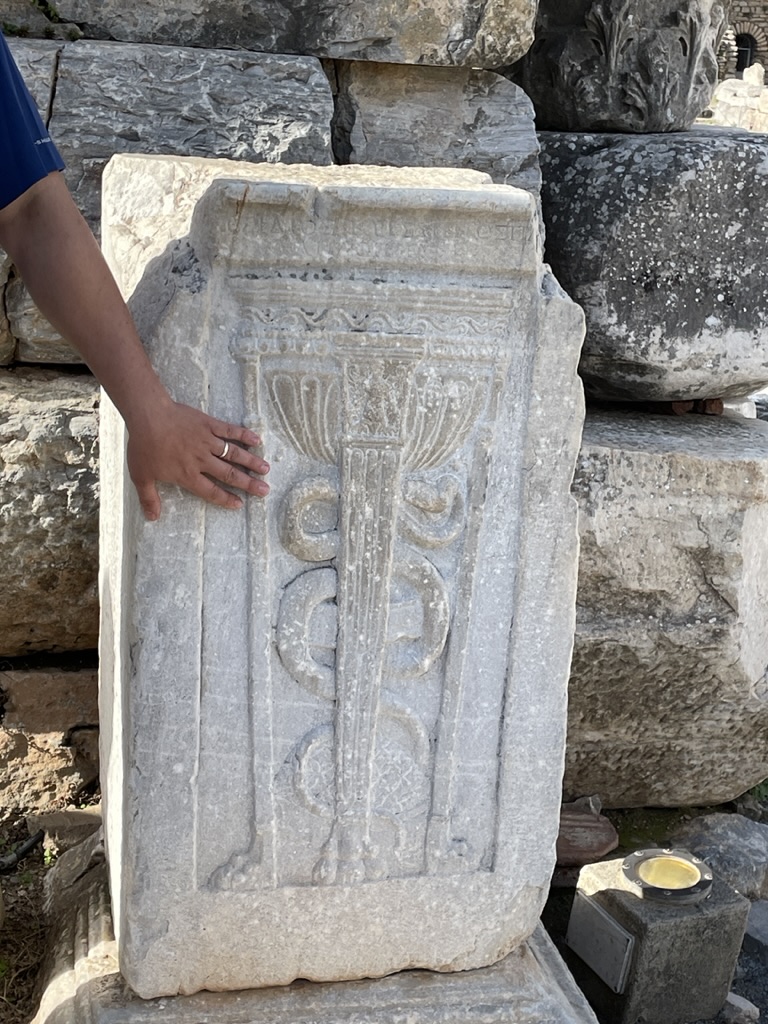
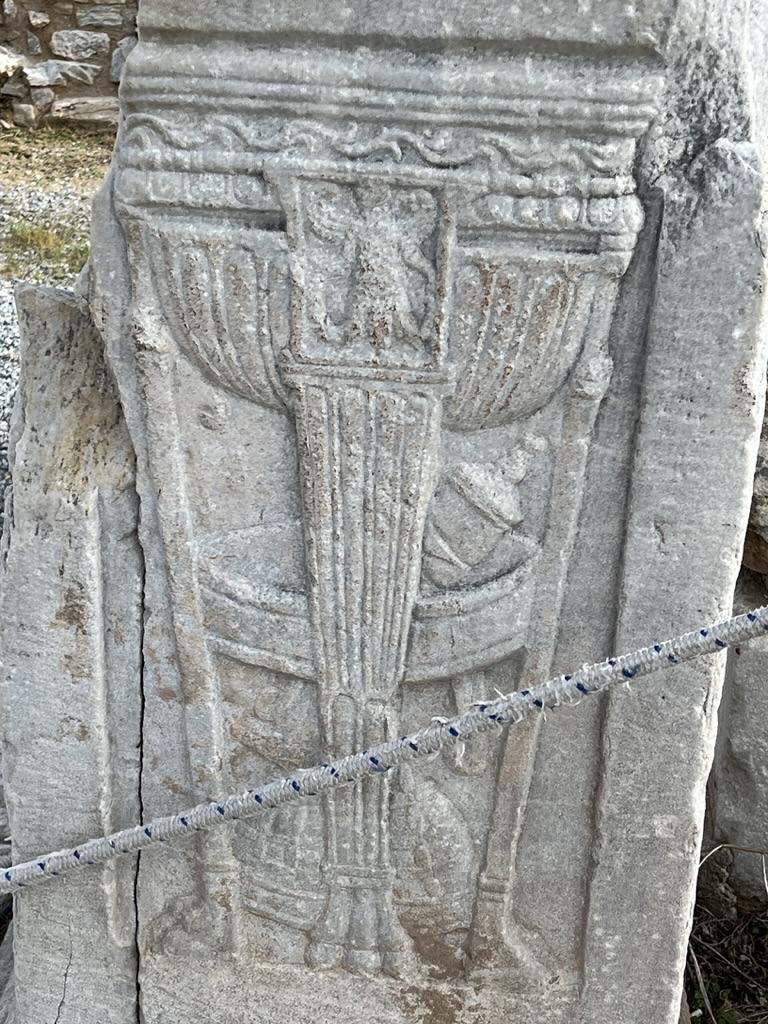
The hospital marked the end of the Government section and the beginning of the commercial section.
About half-way down we came upon this structure:
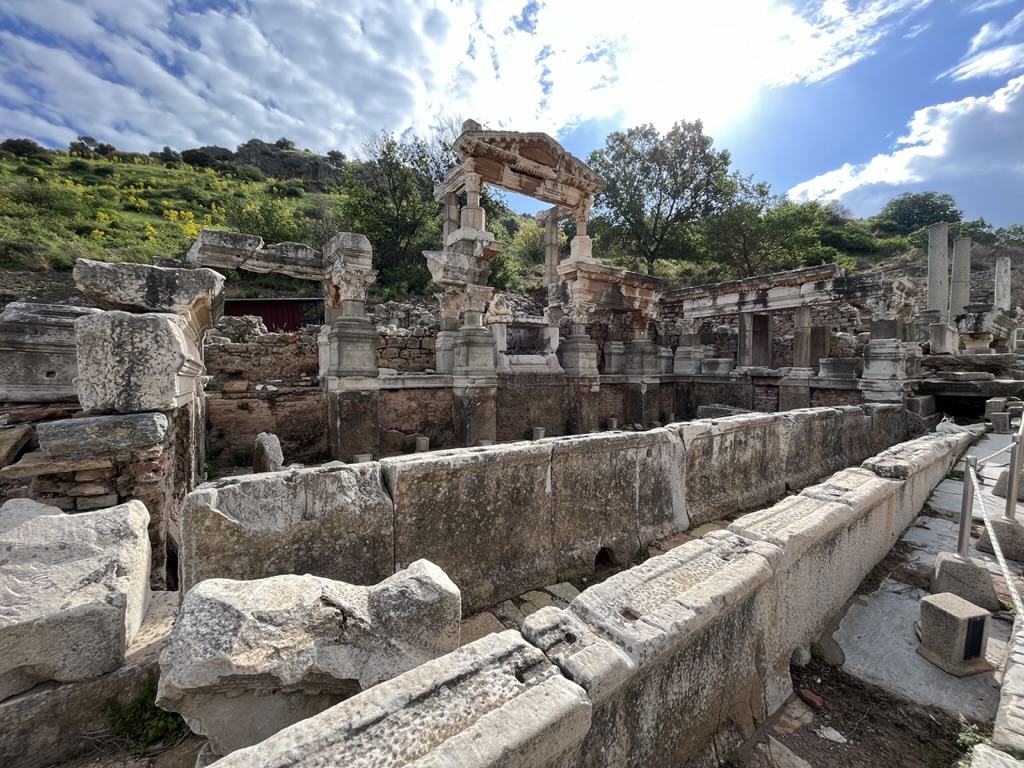
The Fountain of Trajan was built and donated by a wealthy citizen between 102 and 114 AD to honor “Artemis of Ephesos and Emperor Trajan.” Originally it was two stories high with a statue of the emperor standing on a globe over the water outlet.
Further down the street (more toward the center of the city where the homes of the wealthy were built) the quality of the shops on the Agora increased (note the mosaic floors still beautiful after 2,000 years).
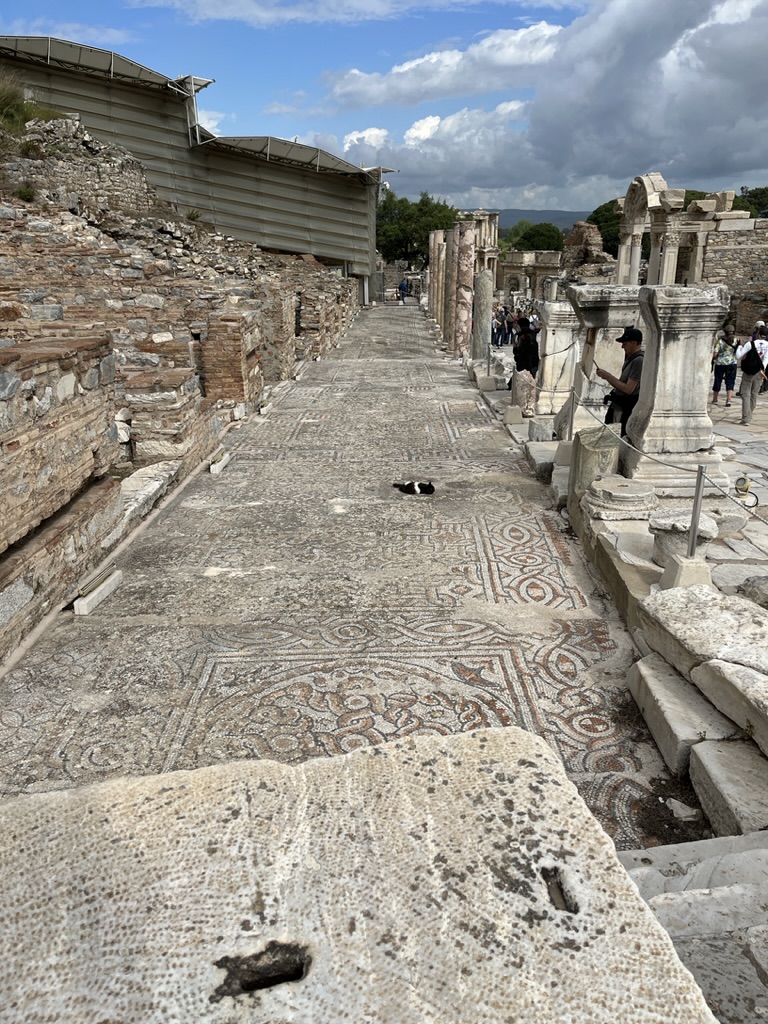
The next monumental building we came to was dedicated to the Emperor Hadrian (AD 117-138) to commemorate his visit. The inscribed statue bases indicate that statues to four later emperors were placed in the shrine.
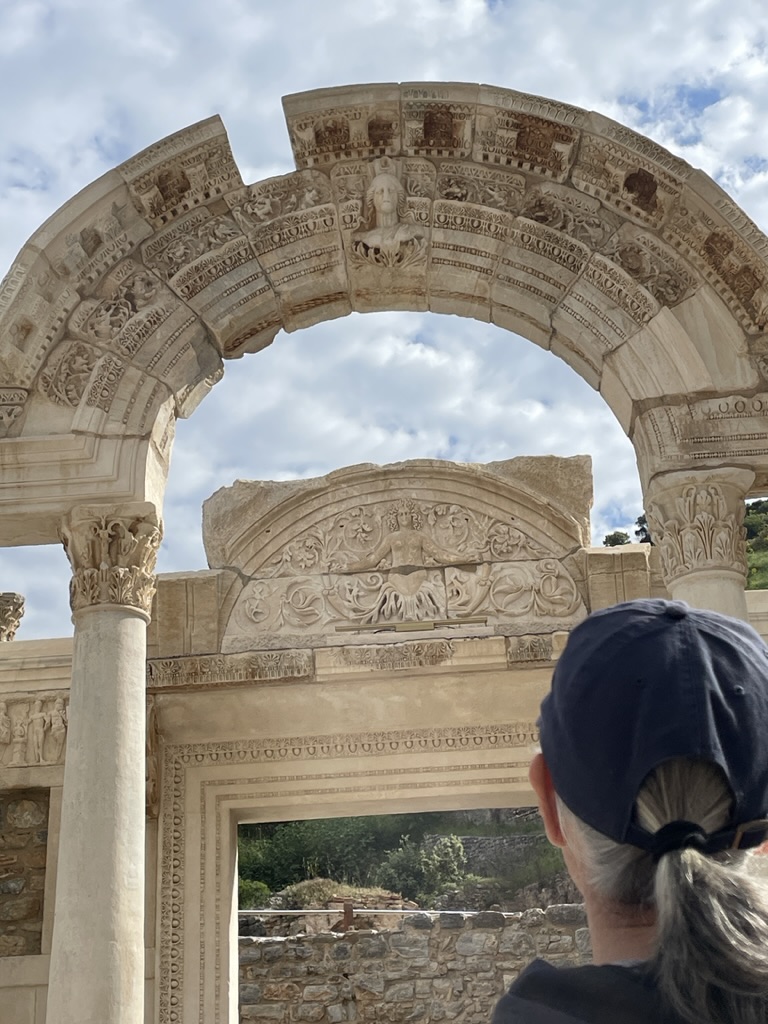
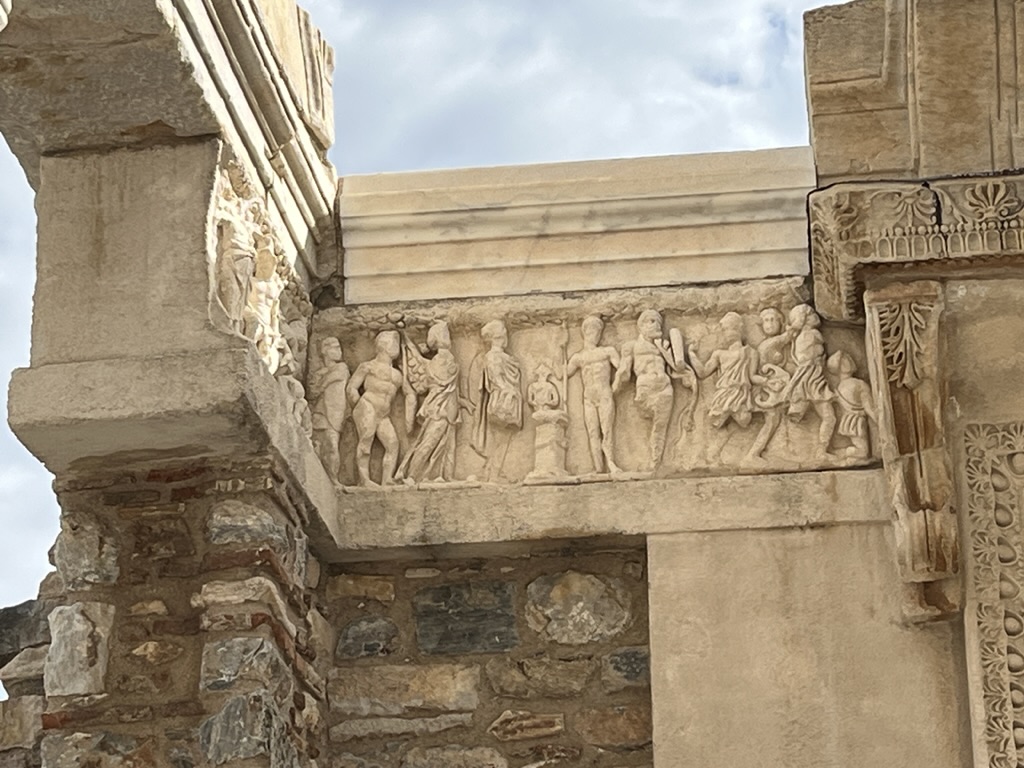
Near this temple we came upon the toilet facilities (only for men) complete with a small “clean” water channel running in front of the seats, as well as the water waste channel that runs under the seats.
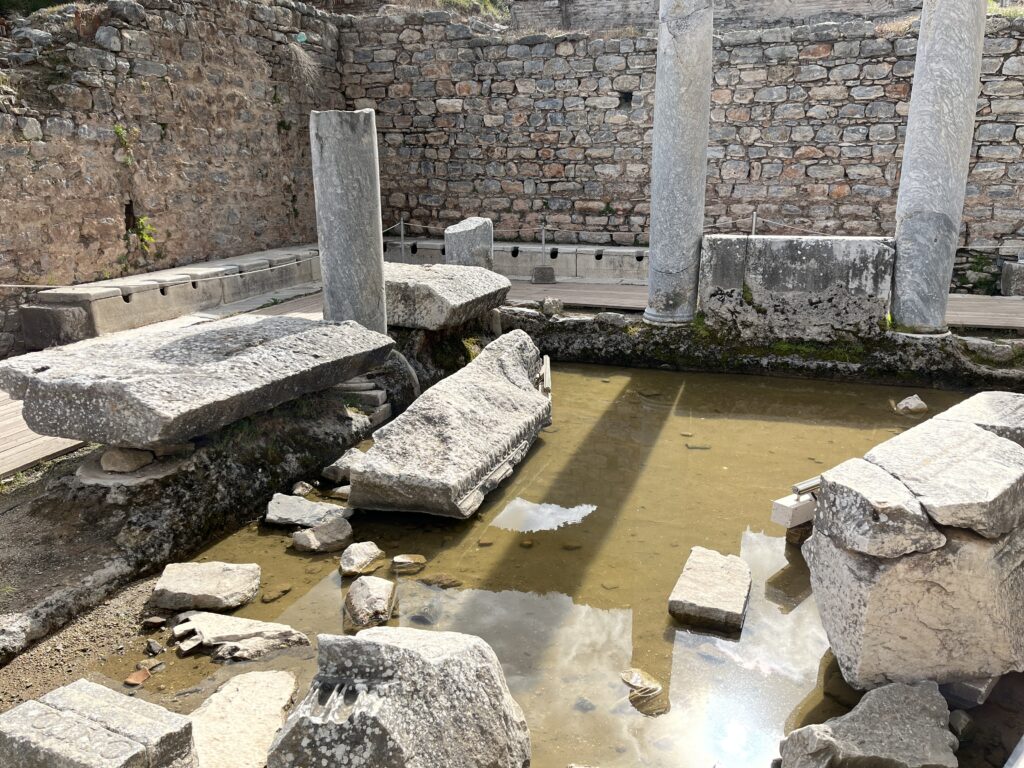
Of course the brothel was right next door.
At the end of the street was the Library of Celsus (built by his son to honor his father, the governor).
This is perhaps the most iconic image of Ephesus. All that’s left of the library is the facade, but before its destruction, its collection was the 3rd largest library in the western world with over 12,000 scrolls.
Leaving the Library we turned right (North) and made our way to the public amphitheater.
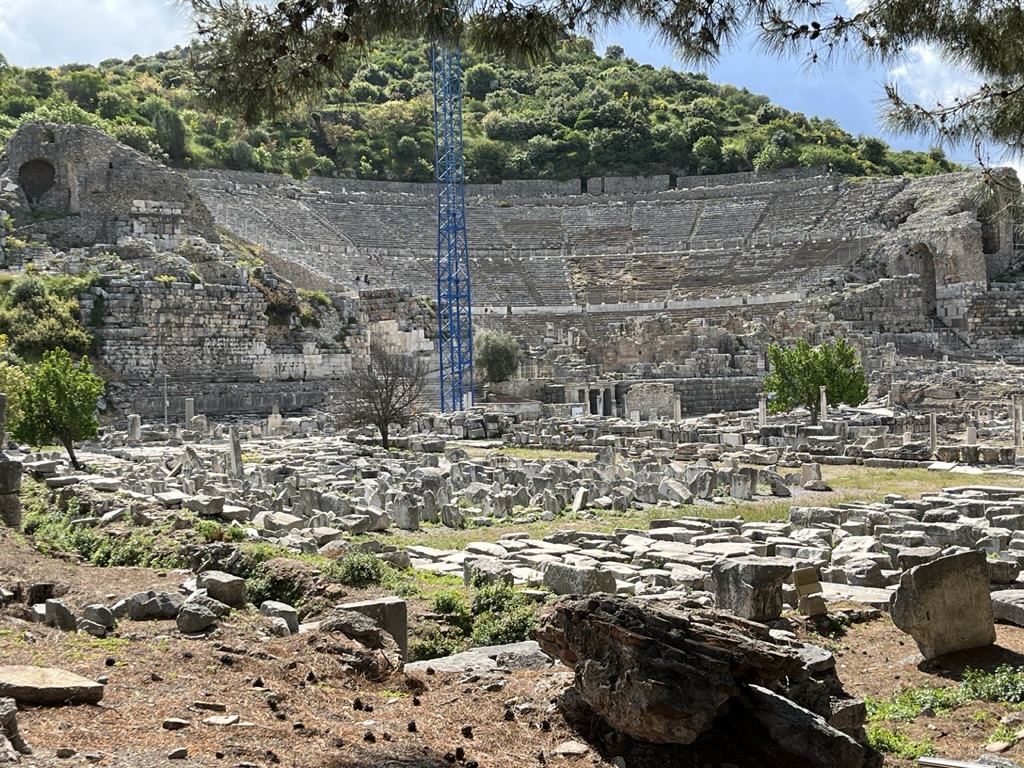
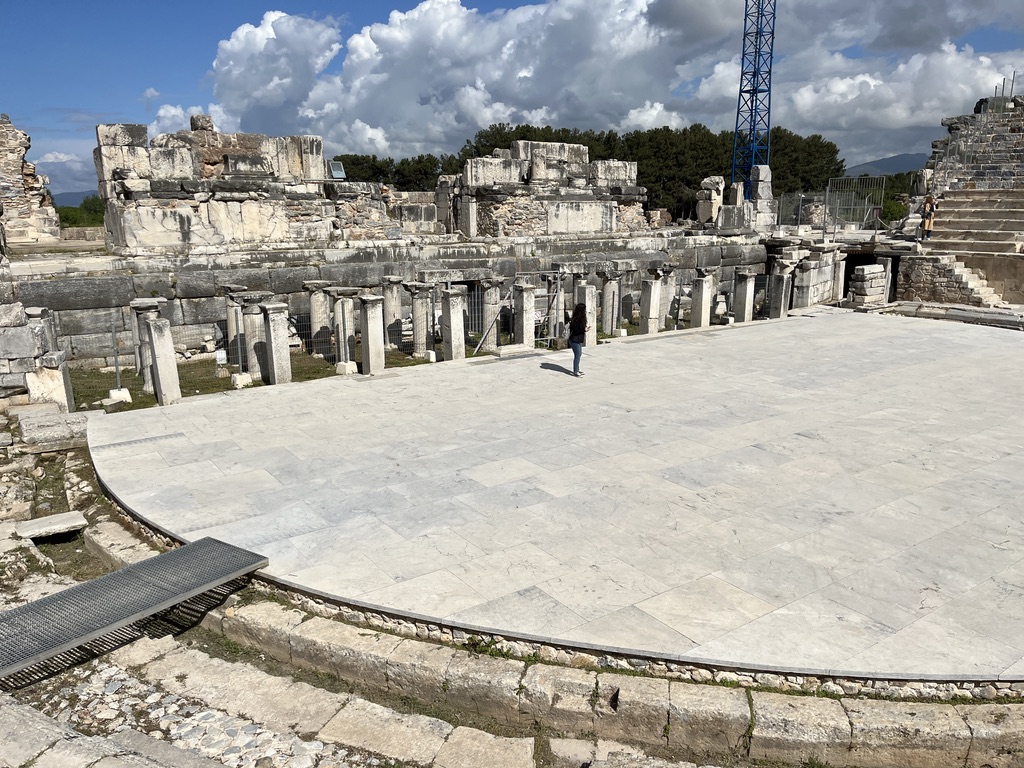
This theatre, seating 24,000 spectators, is believed to be the largest in the ancient world.
Note that the “stage” is lower than the first row of seats so that a platform “wall” separates the seats from the theatre floor. This “wall” protected the spectators and could mean that the theater was also used for blood sports as well as plays. Leaving the theater we walked for a bit on the old ‘Harbor Road’ (now in the middle of fields) before returning to our van.
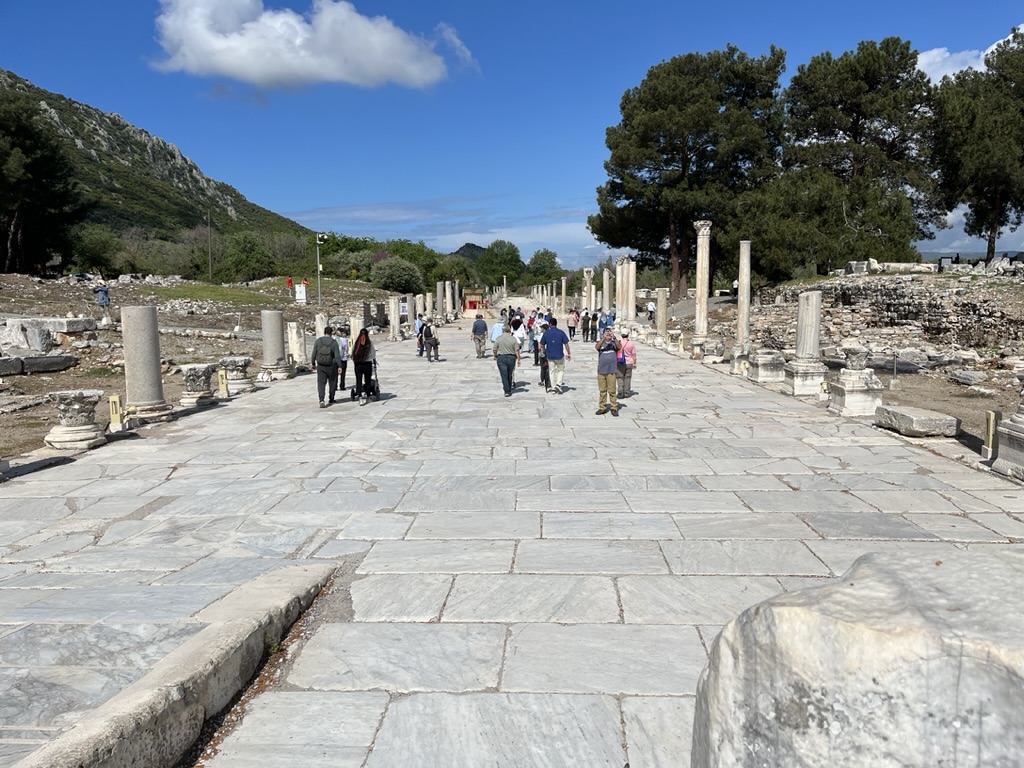
Our next stop was the ruins of the Basilica of St. John – one of the largest churches in the ancient world.
Local tradition holds that John and Mary (the mother of Jesus) retired to Ephesus. We didn’t get to visit the ruins of what is purported to be Mary’s house, but we did visit the Basilica where John’s tomb is located.
Our next stop was an archaeological museum.
Then it was time for lunch.
Ismiel directed us to a D&S (Demo & Shop) rug shop which had a nice little restaurant attached.
Local law requires that every tour include a visit to a D&S rug shop. But one of the advantages of this being a private tour was that we could direct that we not see the demo or the shopping opportunity.
So it was back on the bus to the D&S pottery store. We drank their tea, watched their potter spin a pot (using a kick wheel as opposed to the electric wheel we saw in Rhodes), perused their stock. and escaped without buying anything.
The did have some cool stuff, though! (The Order of the Whirling Dervishes is a Sufi Order established in the 13th century AD / Tulips were brought to Holland from the Ottoman Empire in the 15th century and started a tulip craze – at one point tulip bulbs were worth more than gold and were sold for 10 times what a commoner made in a year / The circular “wine bottle” was carried over one shoulder and simply tipped forward a little to fill your cup with wine.)
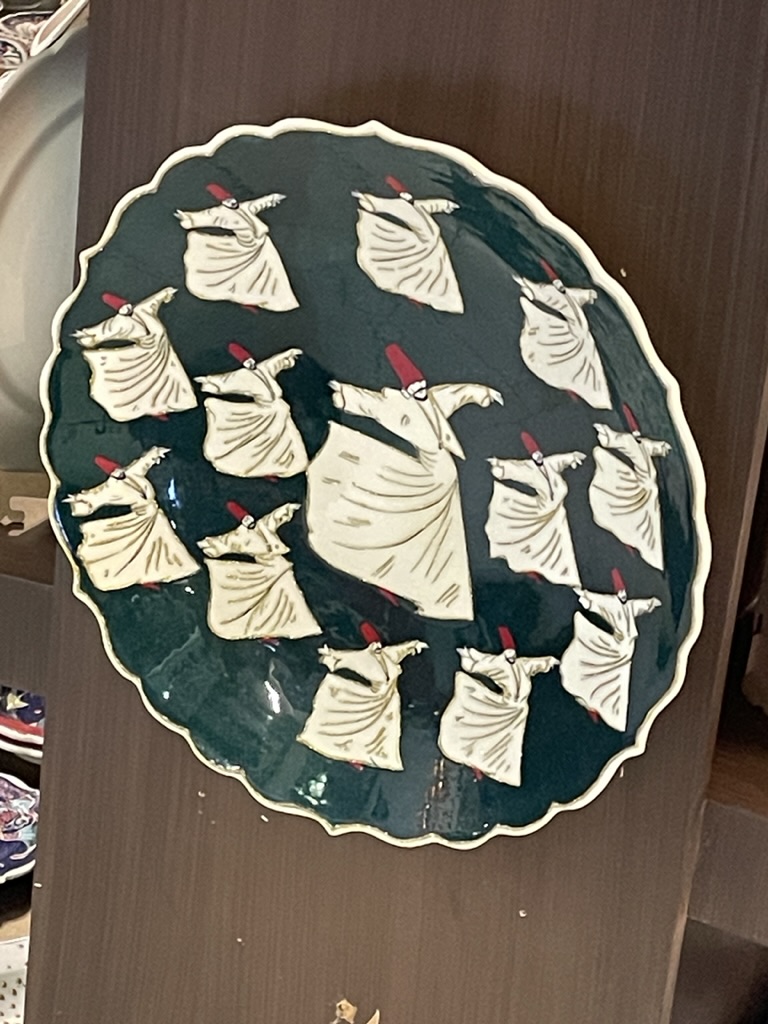
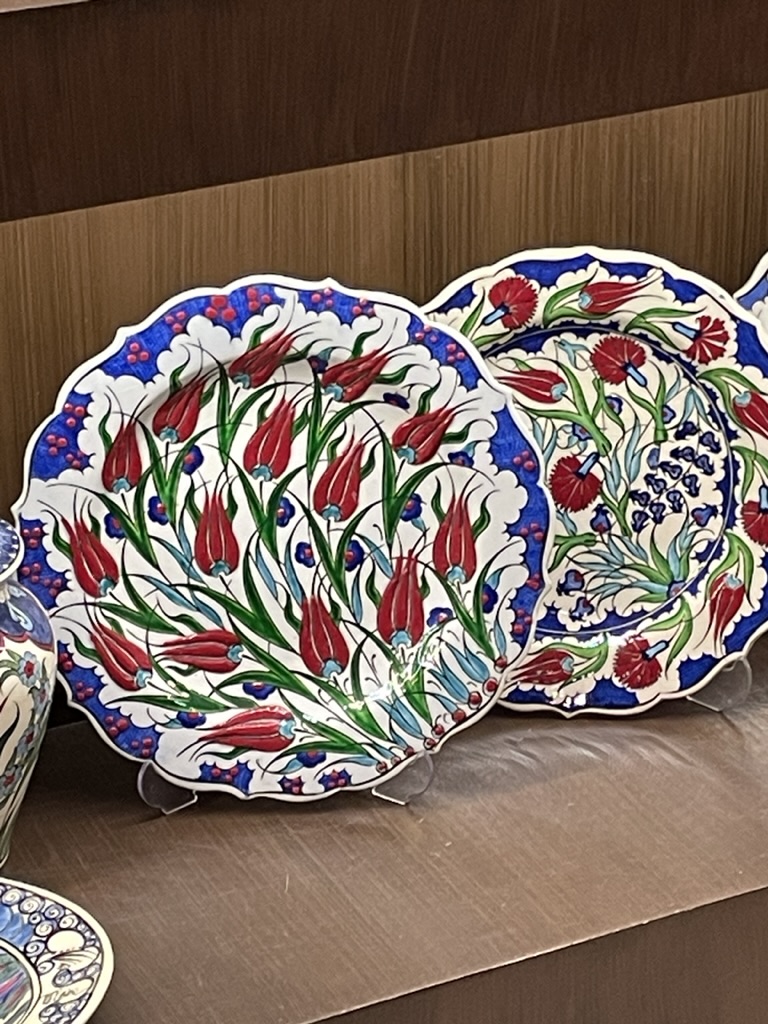
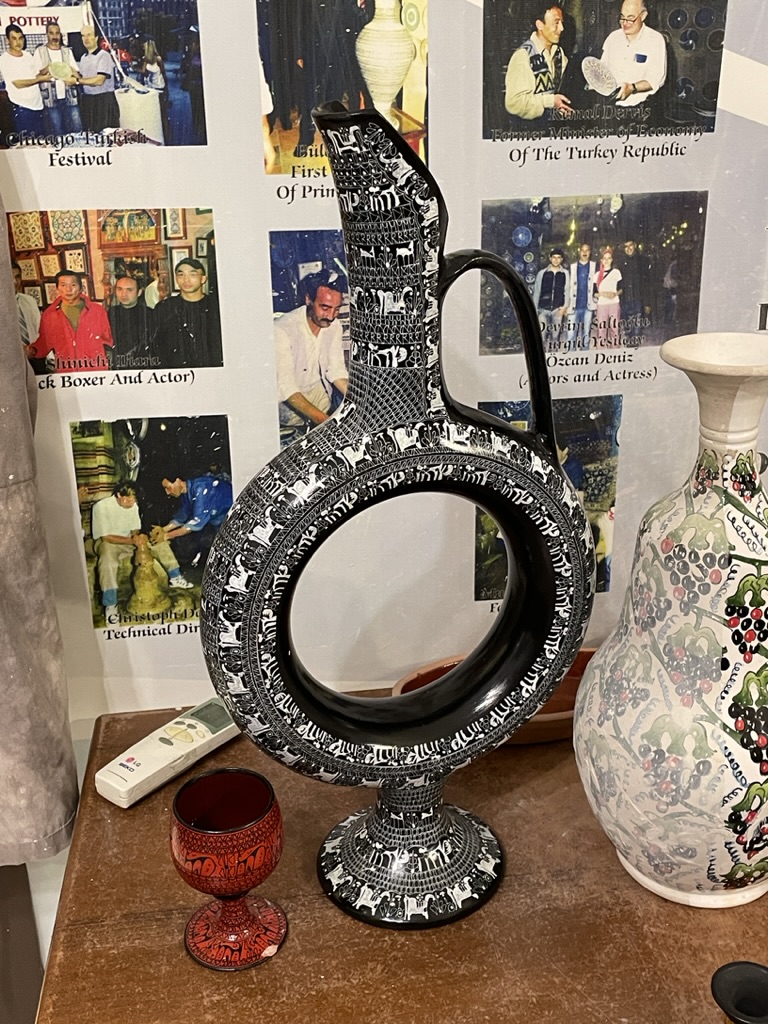
Then it was back to the ship for a bit of a rest before the 4:30 lecture “Eternal Enemies? Issues between Greece and Turkey.”
Throughout the afternoon my scratchy throat and drippy nose turned into a full on cold, so we skipped the 6:30 “Early Mediterranean Voyages” lecture and had an early dinner before racking up a poor 10/23 at BBB.
Along the way we said good bye to Kusadaski…
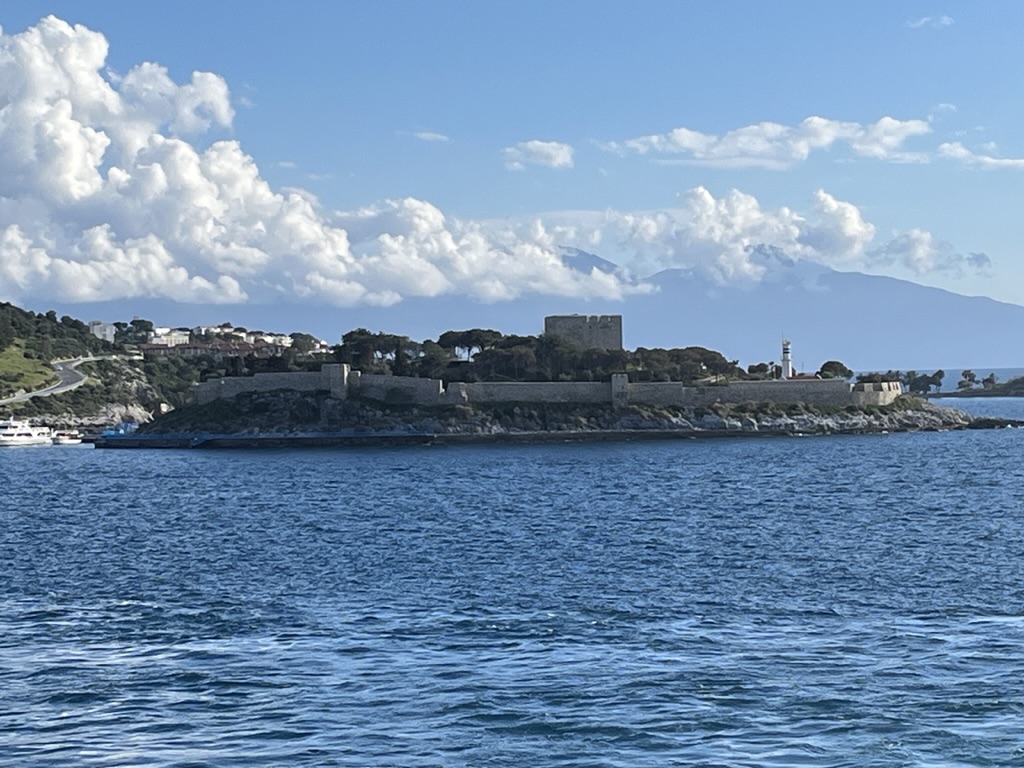
…and enjoyed another great Mediterranean sunset.
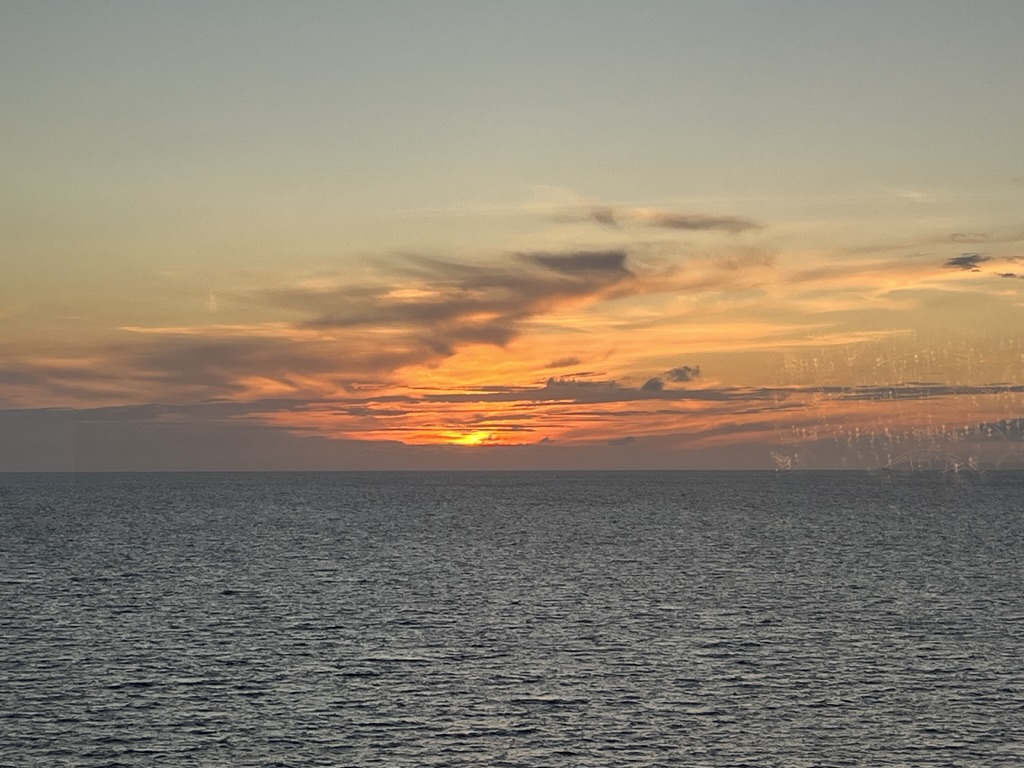
So that’s day 2 of a 4 day port run.
Tomorrow we dock in Istanbul at 6:00 PM and begin with an evening excursion.
Now we sleep.
Nite all,
R
Cheryl’s Factoids:
- Ephesus was supposedly originally founded by the Amazons and named after their queen, Ephesia. It was home to one of the seven Christian churches of Asia mentioned in Revelation.
- The library of Celsus was destroyed by a fire that resulted either from an earthquake or an invasion from the Goths. It lay in ruins for centuries until the façade was re-erected by archaeologists between 1970 and 1978. Celsus is buried in a sarcophagus beneath the library, in the main entrance. which is both a crypt containing his sarcophagus and a sepulchral monument to him. Celsus is also famous for being the first to translate Greek medical terms into Latin.
- Ephesus was home to one of the Seven Wonders of the Ancient world – the Temple of Artemis. It was a gigantic temple with 127 Ionic columns, each 18 meters tall. The temple was destroyed by invading Goths in 262 AD and was never rebuilt. Pieces of the stonework have been taken and incorporated into other buildings. Archeologists rebuilt one column to mark where the temple stood.
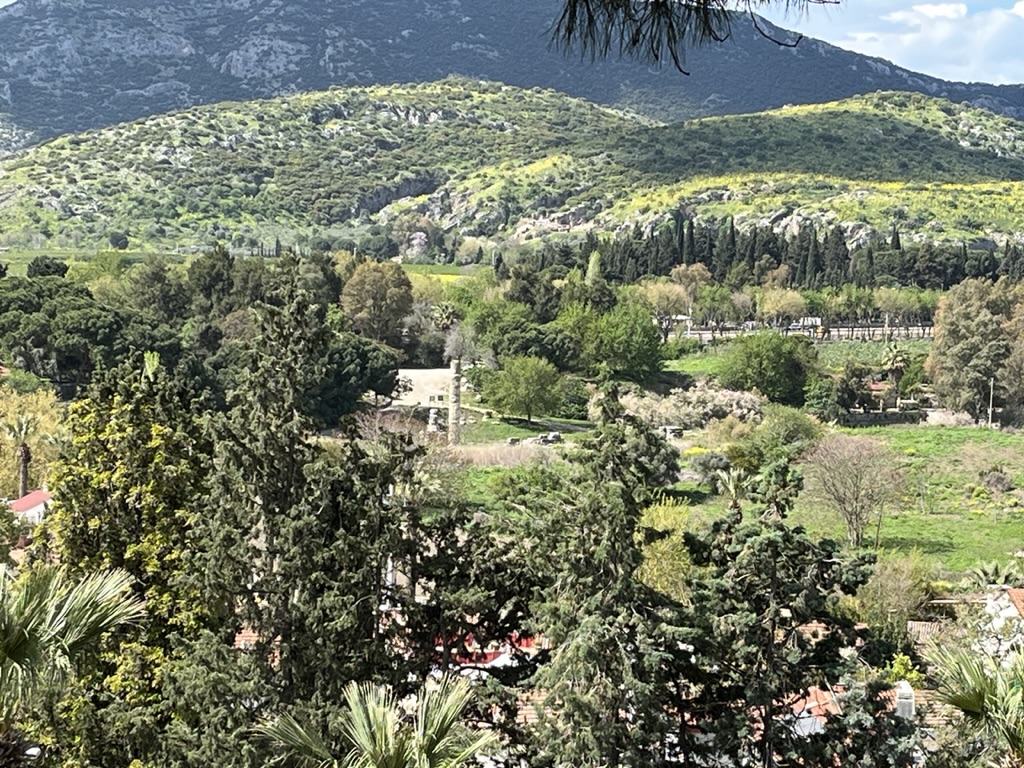
- The apostle John and Mary (the mother of Jesus) were said to have relocated to Ephesus when Jerusalem became unsafe. John started preaching against praying to idols, which the merchants objected to. In 95 AD, John was sentenced to prison on the island of Patmos which was used as a place of exile for convicts. Historians believe he stayed there between 18 months and 3 years. Here John wrote several of the books of the Bible before finally returning to Ephesus. The Basilica of St. John was constructed by Emperor Justinian 1 in the 6th century and stands over the believed burial site of John the Apostle. Some say Mary was buried in Ephesus, others say she accompanied John on his trips to Ephesus but had a house in Jerusalem and her tomb is there.
- Legend has it that the Greek King Byzas, the leader of the Megarian colonists, founded the city that became Byzantium. It is a fantastic commercial site, touching 4 seas (Black Sea, Marmara Sea, Aegean Sea, and Mediterranean Sea). 1,500 years ago the Romans constructed the 3 layers of thick protective walls. Byzantium became the capital of the Roman Empire in 476 BC after the fall of the Western Roman Empire. In 324 BC, after the Western and Eastern Roman Empires were reunited, this city was selected to serve as the new capital and on May 11, 330 BC, and was renamed Constantinople by Emperor Constantine. Constantinople was besieged 25 times by various groups before finally falling to the 4th Crusade (who sacked it then went home, never making it to Jerusalem) and then to Mehmed 11 who took it for the Ottoman Empire and changed the name to Istanbul. The Hagia Sophia, originally built as a Greek Orthodox basilica, was changed to a mosque and 4 minarets added. (When President Ataturk set up the secular nation of Turkey, he changed the Hagia Sophia to a museum but lately it has been changed back to a mosque). The Ottomans were then able to cut off Europe from the Silk and Spice Roads which spurred European nations to find another way to the Spice Islands and the East Indies, thus kicking off the Age of Discovery and world circumnavigation. In 1915, Britain, France and the Russian Empire sought to take control of the Ottoman straits. This would expose the Ottoman capital of Istanbul to bombardment by battleships and cut it off from the Asian part of their empire. With Turkey defeated, the Suez Canal would be safe and a year-round Allied supply route could be opened through the Black Sea to Russia. The Allies tried to force a passage through the Dardanelles which failed and was followed by an amphibious landing on the Gallipoli peninsula. After 250,000 casualties on each side the invasion force was withdrawn. This was a great Ottoman victory but a final surge in the defense of Istanbul as the Ottoman Empire retreated formed the basis for the peoples struggle to become independent from the Ottoman Empire resulting in the Turkish War of Independence. Mustafa Ataturk, a prominent commander at Gallipoli, became the new republic’s founder and president.
- “ETERNAL ENEMIES? ISSUES BETWEEN GREECE AND TURKEY”: After WW1, the surviving Christian minorities within Turkey, particularly the Armenians and the Greeks who had sought protection from the Allies, were seen as enemies and killed. This was exacerbated by the Allies authorizing Greece to occupy Ottoman regions with a large surviving Greek population. The Turkish Nationalists’ reaction to these events led directly to the Greco-Turkish War of 1919-22 and the continuation of the Armenian genocide and the Greek genocide. A formal peace agreement was signed with Greece after months of negotiations in on July 24, 1923, with a compulsory exchange of Greek and Turkish people to their original language nations. Population exchange was promoted as the only viable option to peace. Although a compulsory exchange on this scale had never been attempted in modern history, Balkan precedents, such as the Greco-Bulgarian population exchange of 1919, were available. However, because of the difference in nature and numbers of the populations, the possessions left behind by the Greek elite of the economic classes in Anatolia (their businesses and buildings were claimed by the new state of Turkey) was greater than the possessions of the Muslim farmers left behind in Greece (mostly tobacco farmers) which led to further bad feelings about the forcible removal and exacerbating old feuds simmering since 1922. Recently Turkey and Greece have been sending monetary and food supplies when crises have happened in the other nation (such as the February 27, 2023, earthquake of magnitude 5.6 that hit eastern Turkey which was struggling to rebuild from earlier massive quakes that killed more than 50,000 people. (A lady on our cruise ship from Turkey asked for any old clothing that we would be willing to donate to the earthquake victims – since all we have are adult sizes, lots of people went out shopping for children’s T-shirts in our ports in Sri Lanka, Thailand, and India.)
